
Please send all Checks and Money orders to :
Dave Taylor P.O. Box 87 Sylvania, OH 43560
419-842-1863
Click Here to E-mail Us!
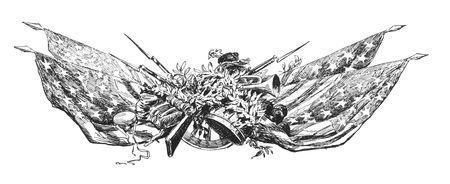

15 08 second list
LAYAWAYS ARE WELCOME:
Need to split your order into multiple payments? No problem! A simple 20% earnest money deposit will hold your item for you.
You can then pay it off in easy installments that fit your budget.
Read Terms Here
~~~~~~~~~~
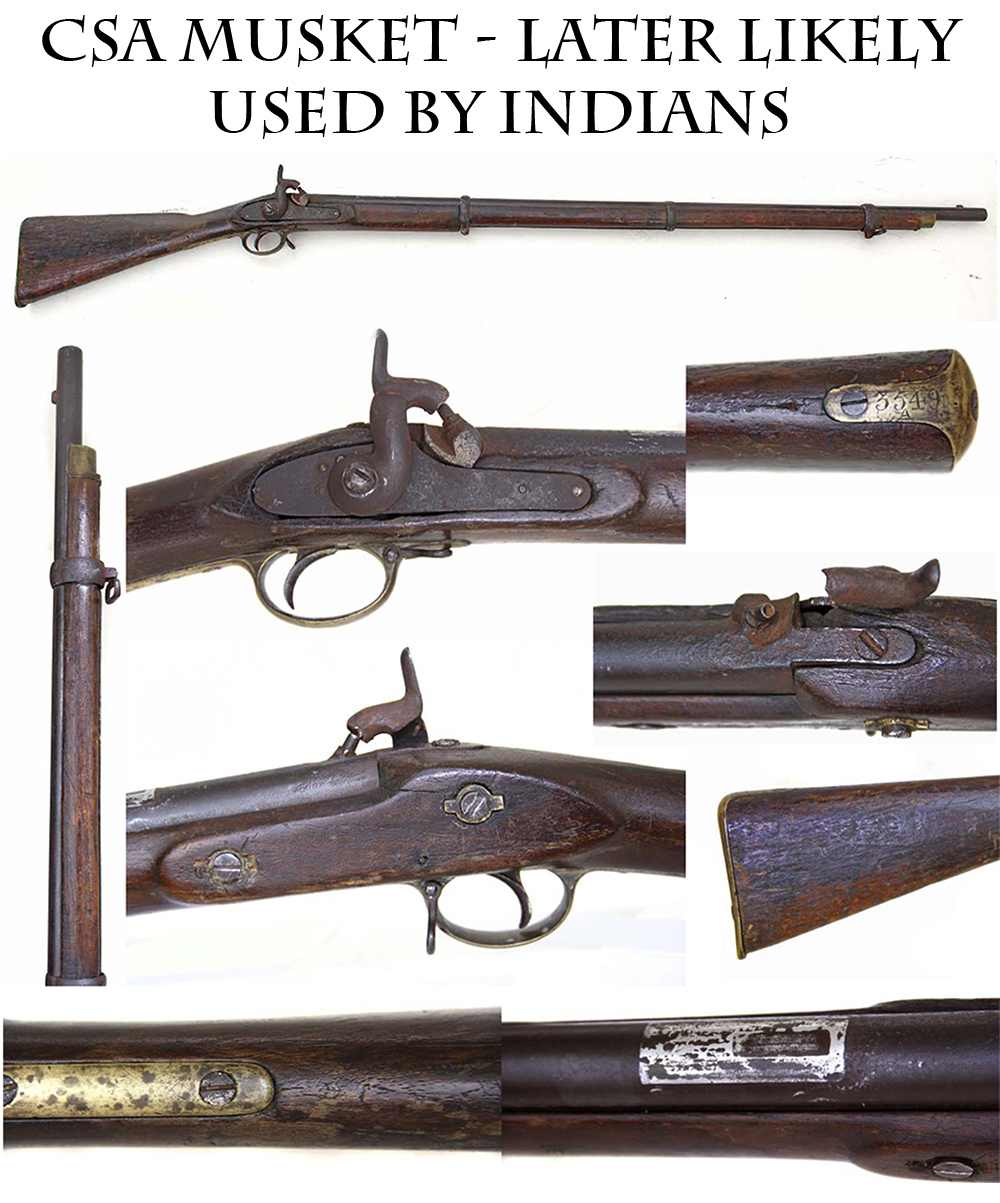
15-08-54 … CSA Musket Later Likely Used by Indians …
This ratty Confederate, Blockade run, Enfield rifle musket was found by Major Steve Kent US Army Retired at the Santa Fe, New Mexico flea market in 2010 or 2011 and purchased for $200. It was a local find from New Mexico. He sold it to me last month and made a hefty four figure profit. It is without question a classic Confederate blockade run musket with the butt plate bearing the engraved Confederate blockade serial number ” 3549-A”. (The A suffix indicating this gun to be in the second lot of 10,000 blockade guns.) The JS – Anchor mark is VERY faintly visible behind the trigger guard tang mixed in with layers of old varnish. The lock is completely unmarked. It is an ill fitting replacement likely done by a frontier gunsmith. That is my gut feeling. I say this because the lock is so crude and unmarked. On the other hand, the lock may be a replacement product of the confederate rifle factory at Tyler Texas. The lock is vaguely reminiscent of their work. In either event the history is easy to conjure. If the lock is the work of a frontier gunsmith (my bet) it was likely traded to an Arizona, Texas, or New Mexico Indian and kicked around long enough to wind up as a stored piece of junk during the 20th century, that someone discovered again in the 21st century and took to the Santa Fe flea market to sell for a few bucks. The poor quality of repair and poor handling are classic elements of Indian carried guns. If the lock is instead a Confederate replacement, then the gun likely saw continued service by an ex reb who went west. Great history in either case. Gun is full length. Front band a wartime replacement off an earlier pattern Enfield. Rear sight is missing. The lock will cock but not crisply. The hammer is off center. Wood has a coating of ancient varnish. Owners name is faintly visible on the stock … ” C.M. White”. For what it’s worth civilwardata shows 251 Confederates named C. White. Of those 13 have the middle initial M. This is a truly wonderful and historic war and frontier Americana relic. It was made in England, run through the blockade, carried by a Johnny Reb through the war, and then saw continued service in the desert Southwest. The stock and butt plate alone are worth what I am asking … abej
… $1,750.00 – SOLD
Click Here to E-mail Us!
Call us @ 419-842-1863
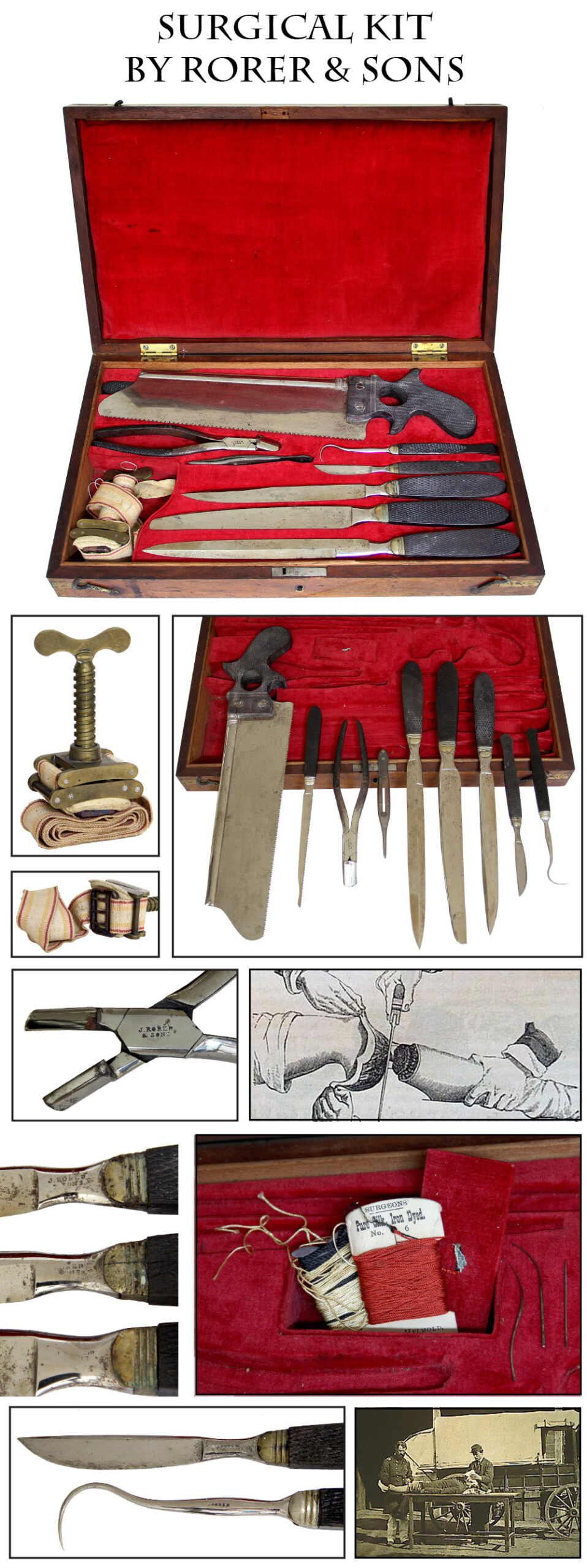
15-08-55 … Surgical Kit by Rorer & Sons …
Of the early Philadelphia surgical instrument makers John Rorer and Henry Schively were perhaps the best in the craft. The city of Philadelphia touted both men as local icons, superb instrument craftsmen equal to Europes finest. Partriarch John Rorer was joined at various times by sons. In 1833 his eldest son William (b.1807) joined the firm which became J. Rorer & Son. In 1850 James B. joined the firm which became J. Rorer & Sons. The kit is perfect and proper to display with Civil War surgical effects both Union and Confederate. It is in magnificent condition. The major tools all have black checkered ebony handles. The tools present are for the purpose of amputation. A gruesome job then and now. Large amputation saw, small saw, tourniquet, amputation knives, rongeur, tweezers, etc. … Kit is complete and all the major tools are signed J. Rorer & Sons. except the tourniquet. This trade name ended in 1857 with the death or retirement of founder John. A top shelf piece of early scientific Americana in outstanding condition … noco
… $3,850.00 – SOLD
Click Here to E-mail Us!
Call us @ 419-842-1863
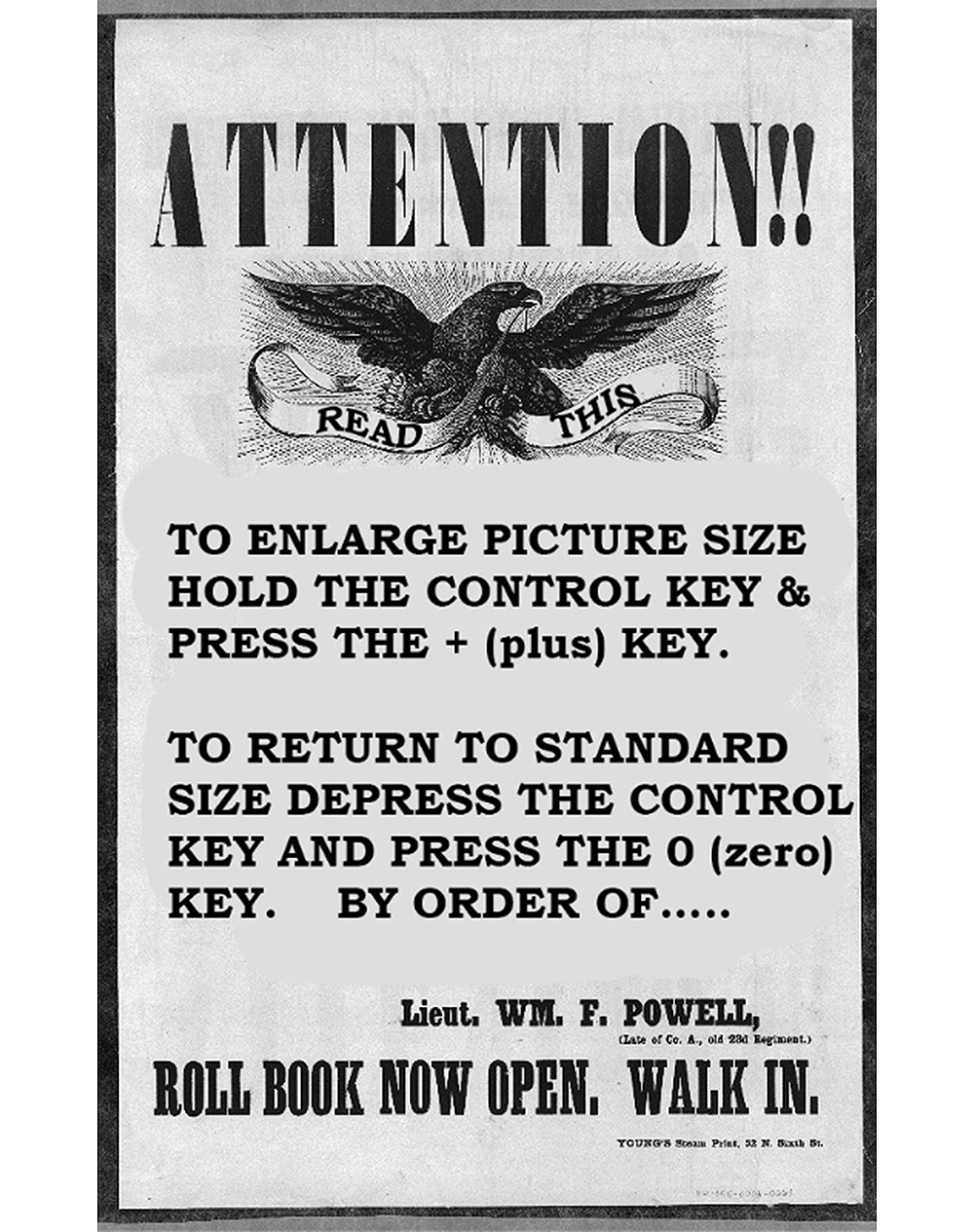

15-08-56 … Wonderful Inscribed Wisconsin Artilleryman’s Saber and Documents/Service in Tennessee …
I don’t find enlisted sabers with historical blade etching but once in a Blue Moon. Here is a real nice one. Excellent M1860 cavalry saber with outstanding blade signed Emerson & Silver Trenton N.J with full inspection marks and date of 1864. Blade retains 95% of the original factory polish and most of the cross brushing at the ricasso. When the soldier took his saber home with him he etched the blade “H A Strebe 1st Wisconsin Artillery 1865”. An original state records document accompanies the saber. Heinrich Strebe enlisted in Company “B” of the 1st Wisconsin Artillery August 3rd 1863 and served into the summer of 1865. He hailed from Milwaukee. A history of the regiment follows…
Three days after the first battle of Bull Run (July 25, 1861), Co. K, 2nd Wis. infantry, was detached for garrison duty at Fort Corcoran near Washington. On Aug. 28 it occupied Fort Marcy and on Sept. 12, one-half of the company was ordered to Fort Ethan Allen for garrison and instruction duty. On Oct. 10 it rejoined the regiment, but on Dec. 9 was permanently detached and organized as an artillery company — the 1st battery Wis. heavy artillery — and stationed at Fort Cass.
This formed the nucleus for Wisconsin’s heavy artillery and on Aug. 28, 1862, a detachment of 40 men, with 3 pieces of artillery, was sent to garrison Fort Buffalo, an exposed post, where it repulsed an attack of the enemy. It returned to Fort Cass in September, moved to Fort Ellsworth in November, and was transferred to Fort Worth in May, 1863. In June Capt. Meservey was authorized to recruit a battalion of four batteries of heavy artillery, using the first battery as a basis.
Battery “B” (OUR MAN’S BATTERY) organized at Milwaukee, Wisconsin, and left the State for Murfreesboro, Tennessee, September, 1863. It was attached to 2nd Division, Artillery Reserve, Dept. of the Cumberland, to December, 1863. Garrison Artillery, Chattanooga, Tennessee to April, 1865. 3rd Brigade, 4th Division, District of East Tennessee, Dept. of the Cumberland, to July, 1865. 1st Brigade, 4th Division, District of East Tennessee, to August, 1865. Duty at Chattanooga, Tennessee, until March 29, 1865. At Athens, Mouse Creek and Strawberry Plains, Tennessee, until September. Mustered out September 21, 1865.
Here is a dead-real Civil War combat saber with dead-real blade inscription tying the saber to wartime service way down in Dixieland in the state of Tennessee
… $1,350.00 – SOLD
Click Here to E-mail Us!
Call us @ 419-842-1863

15-08-57 … Pair of Brass Mounted Child Size or Cadet Size Percussion Muskets …
Two of the greatest little muskets on the planet. Essentially identical. Both are out of my personal collection. At various stages in the young lives of my three boys I bought small size muskets hoping to kindle an interest in old guns. The boys are all grown now and none ever acquired a taste for old guns. I don’t need to keep them any more, so I will let someone else enjoy them. Each of these is a top shelf, high quality REAL percussion musket. One is approx 54 caliber and nicely rifled, the other has been bored out to .65 caliber and is smooth bore. Each has a 32 inch barrel and each is 46.5 inches overall length. The lock, bolster, and butt plate are virtually identical to English Enfield muskets, but the guns are not English. The stocks are similar to US 1842 muskets and the brass barrel bands are sort of like Pottsdam bands except the front sight is on the barrel (not the band) and the size is of course much smaller. My gut feeling is that these are likely Austrian, Saxon, or Prussian. Each is fitted with a bayonet lug under the muzzle end of the barrel and each has a front sight on the top. The gun with the darker stock has the original button tip ramrod. The lighter gun has an original US Civil War rod in it that has been shortened to the appropriate length. The breech of each barrel has a crown over P in an oval, and an oval surrounding a U or similar device. I am not familiar with which country these markings hail from, but still guessing Germanic. Both are VG to near fine. Both function perfectly. I don’t know of another pair for sale elsewhere … gej-cow/noco
… $2,400.00
Click Here to E-mail Us!
Call us @ 419-842-1863
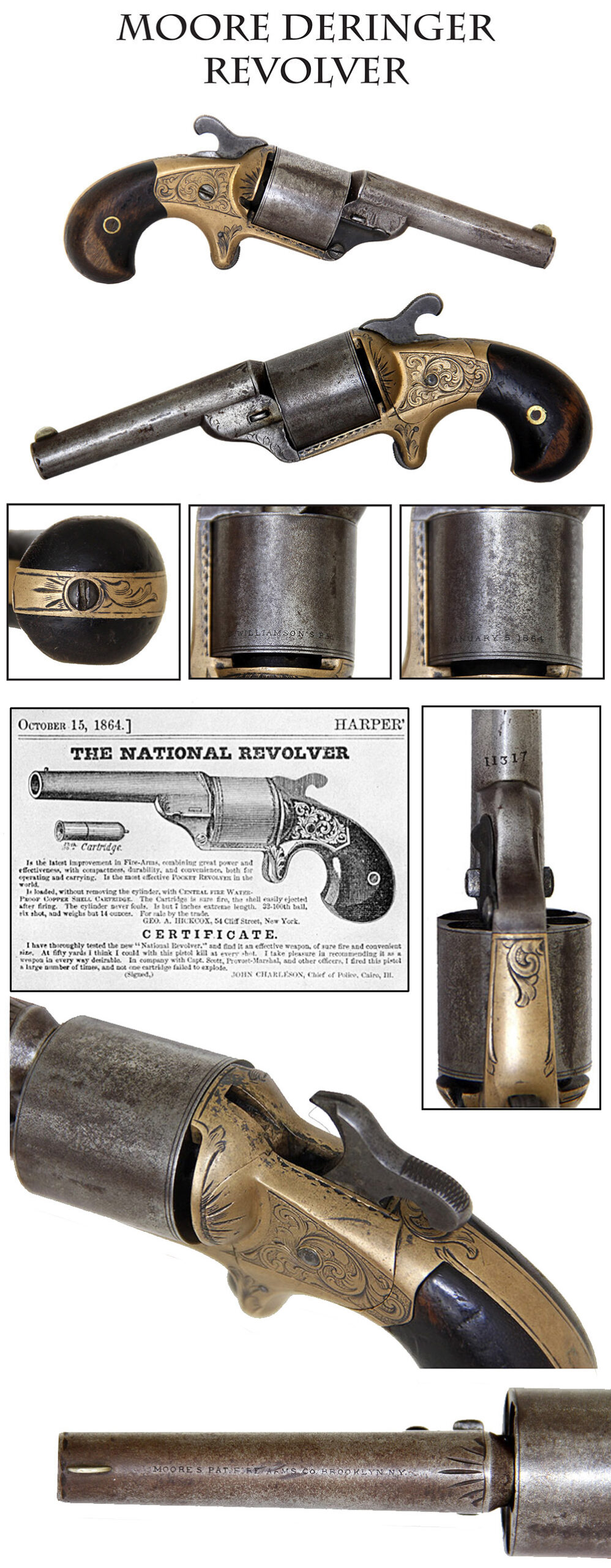
15-08-58 … VG++ Condition Moore Teat Fire Revolver …
These interesting 32 caliber pistols were designed by Daniel Moore and manufactured by Moore and his partner David Williamson. The Moore .32 Teat-fire, used a unique cartridge which circumvented the Rollin White patent owned by Smith and Wesson. These small revolvers proved very popular during the Civil War, with both soldiers and civilians. The “Teat-fire” cartridges did not have a rim at the back like conventional cartridges, but were rounded at the rear, with a small “teat” that would protrude through a tiny opening in the rear of the cylinder. The priming mixture was contained in the “teat” and when the hammer struck it, the cartridge would fire. Cosmetically this example is about FINE condition with much original factory blue still remaining. Mechanically the gun will cock just fine and the cylinder rotates just fine, but the cylinder stop (lock). But we’re not going to fire it so I won’t worry about it. This is the early model marked Moore’s Pat Fire Arms Co. Brooklyn as opposed to the National Arms marked examples … 415cc
… $550.00 – SOLD
Click Here to E-mail Us!
Call us @ 419-842-1863

15-08-59 … Model 1840 Heavy Cavalry Saber …
A very solid example of the cavalry weapon used by troopers both north and south. This is a German import bearing the Solingen knight’s-head maker’s logo. The leather grip and twisted wire wrap are a restoration, the balance of the saber is original and as used. The 3-branch brass guard is very nice with delicate yellow patina. The blade is good grey steel with crisp edges and no edge nicks. The scabbard is likewise very good. … rich brown age patina and no dents. Very solid and very displayable. With the grip restoration you could use this in living history or reenacting without fear. A good affordable example … caj
… $435.00 – SOLD
Click Here to E-mail Us!
Call us @ 419-842-1863
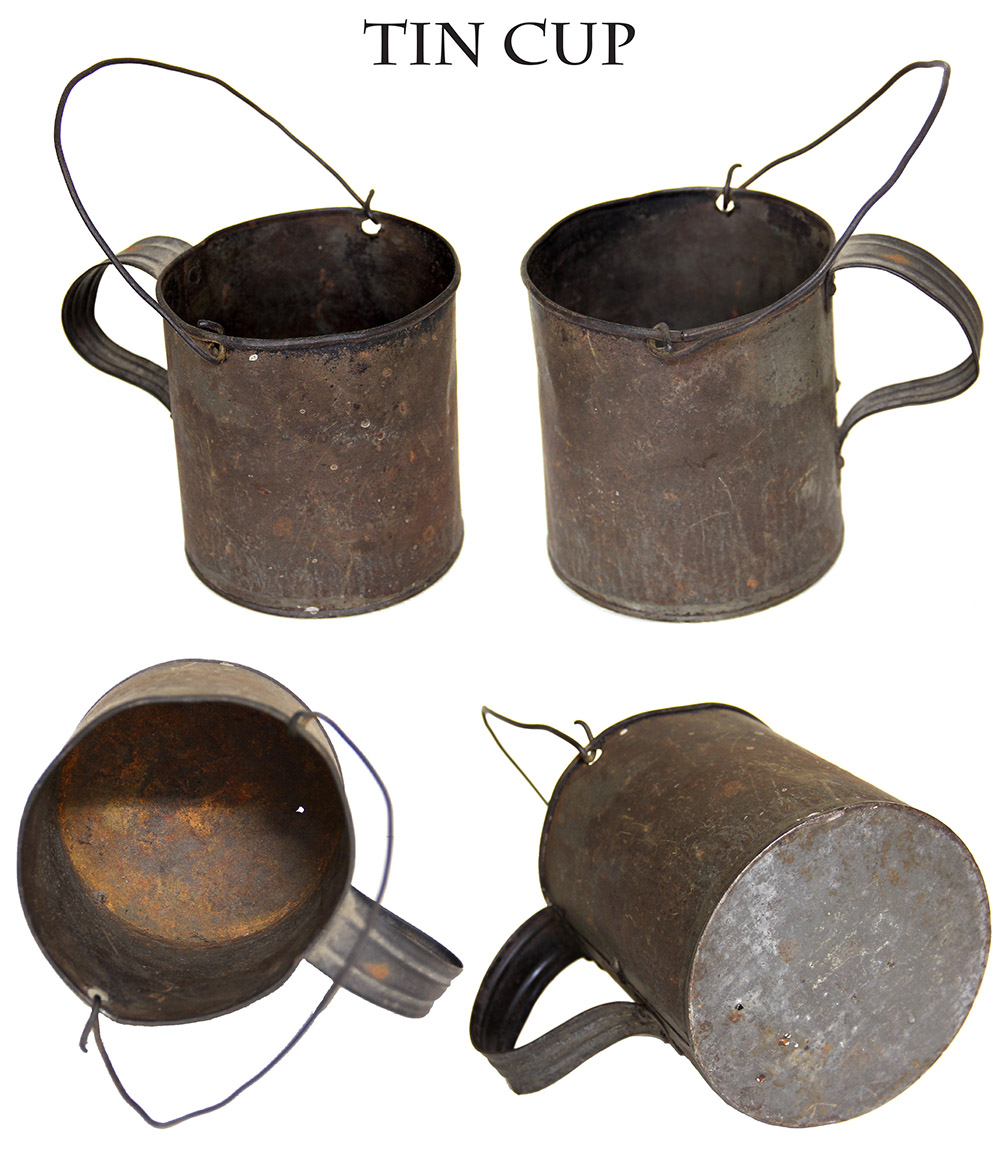
15-08-60 … Civil War Tin Cup with Bail Handle …
Not a government issue cup, but a good mid 1800s period cup of the same dimensions as the issue cup, and more interesting with the wire bail handle at the top. Shows great age, but no damage. I cannot state for sure this was used in the military… but there is as good a chance of that as it having been used by a hunter or frontiersman … noco
… $125.00 – SOLD
Click Here to E-mail Us!
Call us @ 419-842-1863
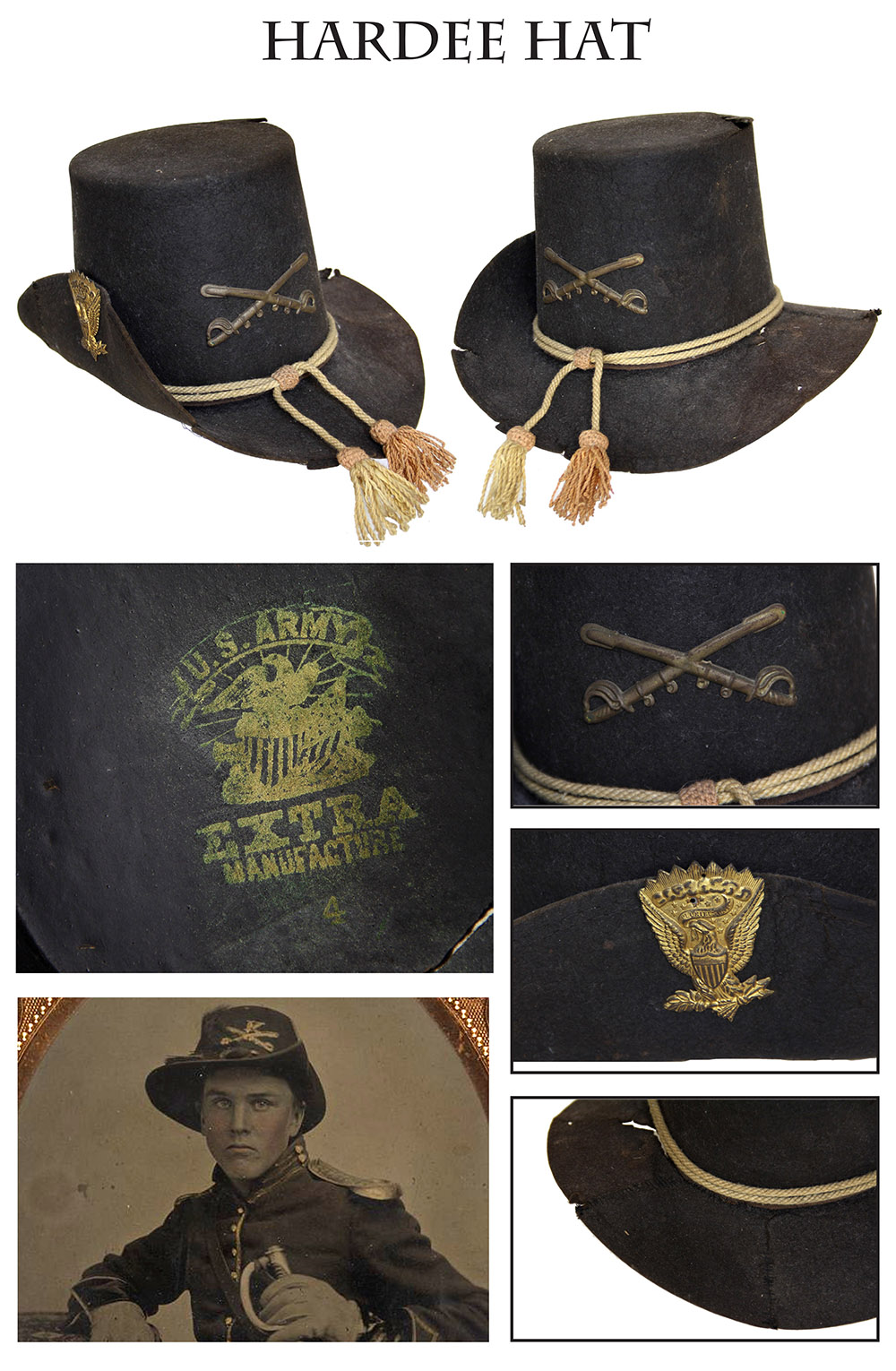
15-08-61 … US Regulation Hardee Hat …
Regulation US Army 1858 dress hat, aka the “Hardee” or “Jeff Davis” hat. A version of this hat was adopted in 1855 for the new cavalry regiments, and became regulation for all branches of service in 1858. With one side of the brim turned up with a brass pin bearing the arms of the United States, a colored hat cord designating the branch of service, brass service and unit insignia on the front, and a plume besides, these were impressive pieces of headgear, though subject to some complaint on the grounds of comfort. They look particularly dashing in their cavalry configuration, like this one, but are also associated with the infantry, particularly the Iron Brigade, whose commander insisted on regulation US army uniforms.
A decade ago at a New Hampshire auction the US Army museums paid over ten thousand dollars each for mint examples. Yes that was crazy but back then the realistic value was 5 to 6 thousand. This one is priced affordably due to the current market conditions and some issues with condition. It displays very well, but there are plainly numerous tears and rips and some repairs around the edge of the brim, base and top edge of the crown and one extending from edge of brim to base of crown that has been partially repaired. The original crown lining is in place with its “US ARMY / EXTRA MANUFACTURE” lettering above and below an eagle on shield, and a size “4” stamp as well. The cavalry crossed sabers device and hat cord are original. These are easily worth $350 all by themselves. The brass side eagle is well aged, but not original and the hat lacks the sweatband, which of course will not be visible in a display. This is well used, but priced way under mint surplus examples, and probably looks like 99 percent of them did that were actually used and worn home
… $2,150.00
Click Here to E-mail Us!
Call us @ 419-842-1863

15-08-62 … Civil War Era Sex Manual Copyright 1860 …
Everything you wanted to know about marriage and the birds and bees, but were afraid to ask: “The Marriage Guide, or Natural History of Generation; a private instructor for married persons and those about to marry, both male and female…” by Frederick Hollick, M.D. Bears an 1860 copyright date on the back of the title page. An interesting bit of social history that must have been a popular volume since this boasts to be its 200th edition. Cloth bound, a little loose in the binding, embossed covers and blindstamped spine. Complete with “numerous engravings and colored plates.” Victorians were proverbially reticent on the topic of sex, but this shows that some things don’t change and even they realized there were some things necessary to know. I had to lock this up in the office to keep the staff at work, but I am looking forward to reading Chapter IX, The Philosophy of Amative Indulgence. Helper Tom seems most interested in the engravings and colored plates. I imagine copies got passed around more than one winter hut to pass the time in army camps. About the size of an army tactics manual but a little bigger
… $185.00 – SOLD
Click Here to E-mail Us!
Call us @ 419-842-1863

15-08-63 … Re-enactor’s Dream Group …
Wouldn’t it be great to find a trove of original material like this? Even as reproduction items it’s real impressive. The battle flag of the 74th Illinois, a bummer cap, regulation haversack and dark blue canteen, infantry waist belt and plate with cap box, cartridge box and sling with plates, soldier’s wallet, housewife (sewing kit), large camp size tin coffee pot, single brass candle holder, a set of brass donut style candle sticks, etc.- I had to look at the donut candle holders for a long moment to determine if they were old or new. Those are damn near perfect copies of the originals. The lot is pretty impressive even knowing that it is all replica material. It displays like a grand finale, or is ready for use in living history. Selling as one lot, ready to go for a display, school lectures, or even use once again in the field. The whole kit and caboodle … noco
… $295.00 – SOLD
Click Here to E-mail Us!
Call us @ 419-842-1863
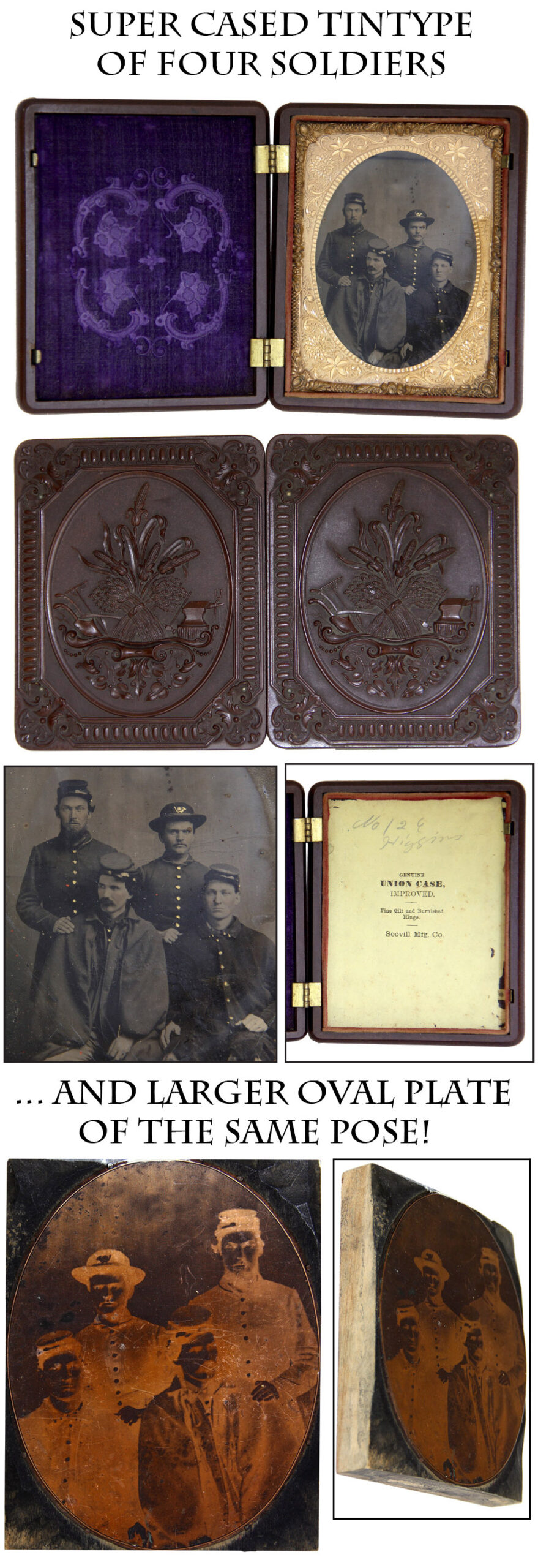
15-08-64 … Quarter Plate Tintype & Copper Printing Plate …
A fine, clear quarter-plate tintype of four yankee soldiers in a very nice thermoplastic case, along with a printer’s block used to publish the image. Group views like this are on the real scarce side. There is a good chance this image can be identified since the included printer’s block indicates the image is published in a regimental history. Someone is going to recognize this view. It is a nice clear image, strongly posed, showing four soldier “pards”, two seated and two standing. The two in the back wear regulation enlisted frock coats with their collars turned down. The fellow on the right has a hunting horn insignia with something in the loop, but the photographer gilded it and obscured what was in the center. The two seated figures wear caps and overcoats. The fellow on the right, a darker overcoat like many issued to early war recruits. The fellow on the left might be an officer: loops and frogging of a “cloak coat” show beneath the cape. He is seated (a position of authority) and he is the only one not looking directly at the camera. The case is a nice Scoville “Union Case” with beautiful blue velvet facing pad, and a clear label. It depicts a harvest scene front back, inside an oval border with geometric and floral motifs edging the case, and no chips or damage. My guess is that one of you is going to recognize this image and increase the value by a goodly proportion. Well worth
… $495.00 – SOLD
Click Here to E-mail Us!
Call us @ 419-842-1863
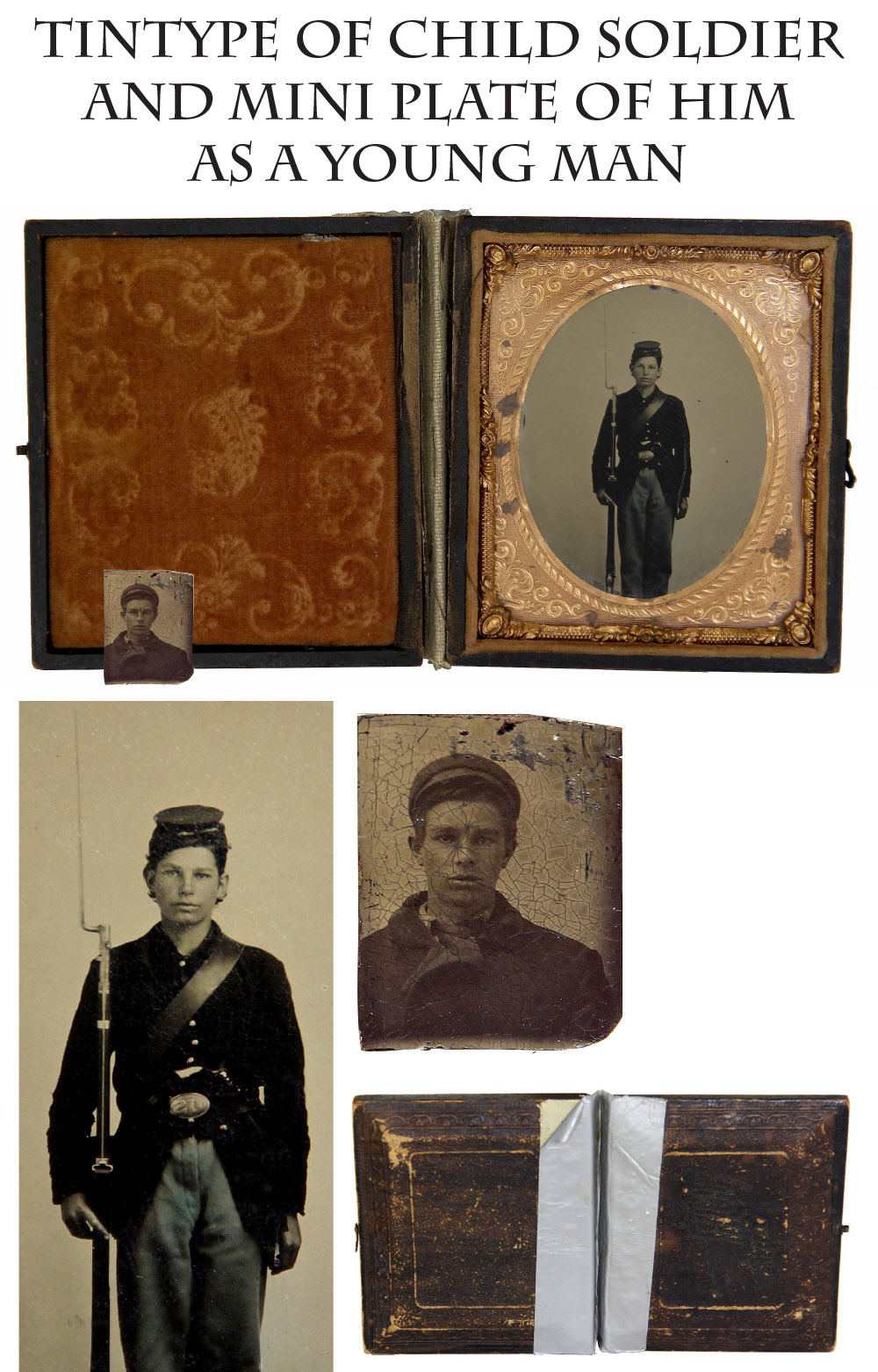
15-08-65 … Sixth Plate Tintype of Very Young Soldier + …
Sixth plate tintype of a young boy as a soldier and a later gem-size tintype of him in civilian clothes after the war, as he was starting to come into manhood, but still young for all his experience. This has got to be one of my favorite sets of images. We are familiar with young soldiers during the Civil War. This set reminds us that after three or four years of service, they were still young, with the longest part of their lives still ahead of them. Here is a crystal clear cased wartime tintype in leatherette case with mat, frame and glass, showing a boy who is no more than sixteen outfitted with a rifle-musket and accoutrements, with a pistol shoved in his waist belt for extra effect. The photographer carefully tinted his trousers regulation sky blue and the boy has arranged his gear to best effect, throwing his cartridge box over the wrong shoulder and perching the bayonet on the rifle muzzle so that it would appear on the correct side when viewed in a reversed tintype. Even the bare background puts the complete focus on the young man. Especially touching is the small gem-sized tintype accompanying the image that shows the same boy a few years older but still a very young man. We know how many recruits avoided the age restrictions on enlisting by lying, subterfuge or just getting a parent’s permission. A high percent of the ages listed as 18 in the records are just “c-y-a” bookkeeping to stay consistent with the regulations. Here is a reminder that after serving three or four years in the army, they were still “boys” chronologically… but battle hardened veterans at their core. Some idiot used duct tape to mend the separated hinge on the photo case. Other than that this is a splendid piece of photo history… the sort that doesn’t show up much any more … noco
… $395.00 – SOLD
Click Here to E-mail Us!
Call us @ 419-842-1863
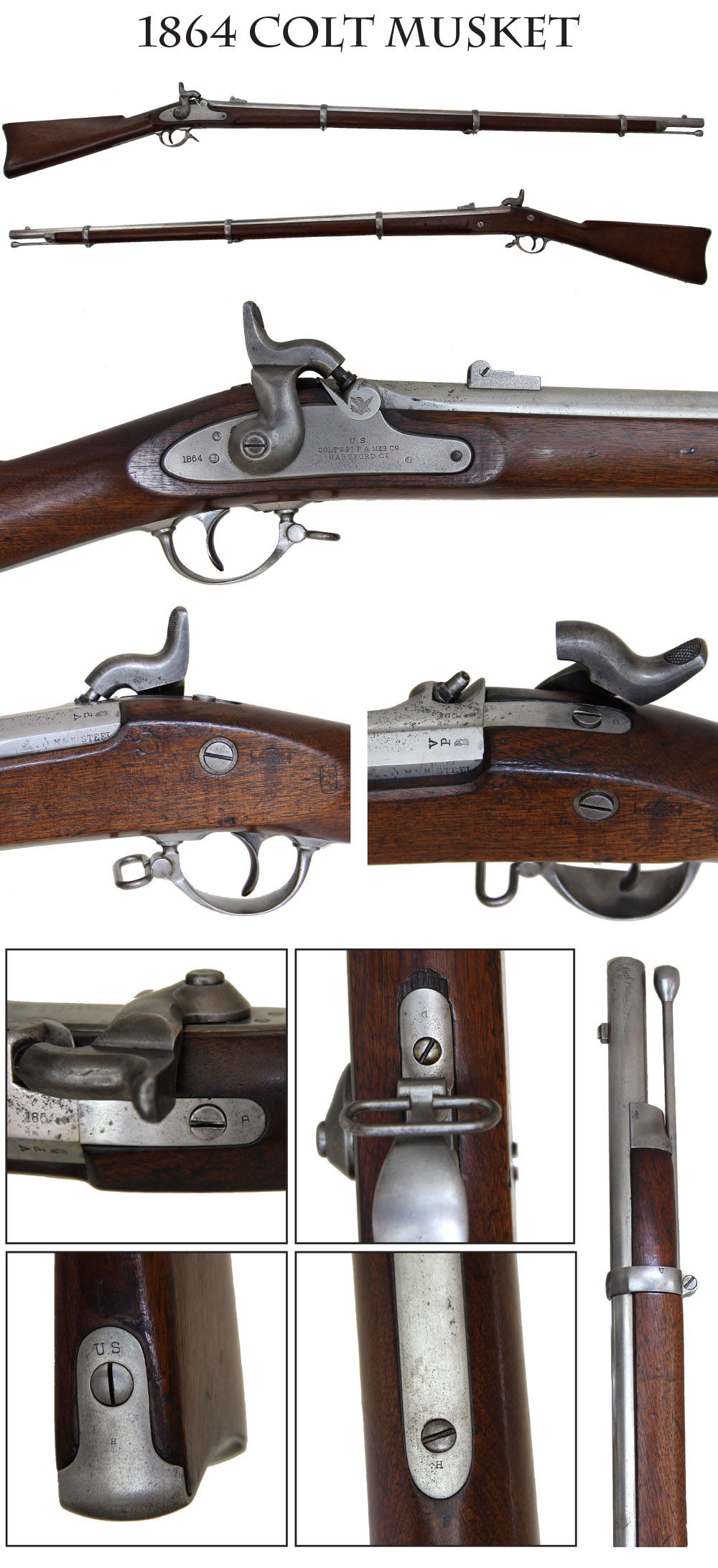
15-08-66 … Fine Condition Colt Model 1861 Special Musket Dated 1864 …
Manufactured from 1861-1865, One of about 75,000 Colt Special Model 1861 Muskets produced. This particular 1864 dated example is in NRA “fine” condition. Stamped with an American eagle on the bolster and the date clearly behind the hammer, as well as the full Colt firm name. As is customary with Colt M1861 Special Muskets, the word “STEEL” appears on the left side of the breech. Top of breech is stamped with matching 1864 date, the “4” is faint. Bore is about mint. Wood has good edges, great color, and very visible inspector cartouches on the left side opposite the lock. 100% original, 100% complete, and mechanically perfect. The fact that Colt firearms are the most collectible guns in the world, these Civil War Colt muskets always carry a strong value and have good desirability
… $2,650.00 – SOLD
Click Here to E-mail Us!
Call us @ 419-842-1863
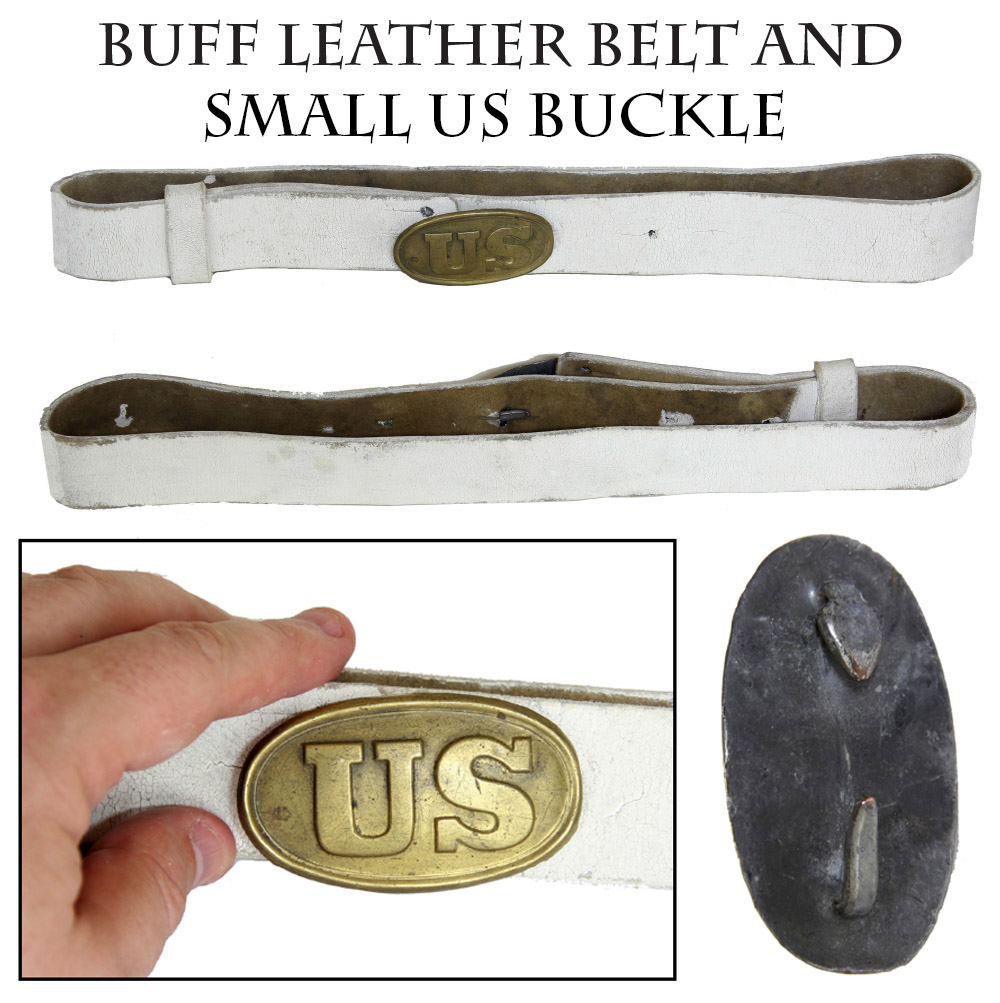
15-08-67 … M1839 Small US Buckle on White Buff Belt …
Mexican War period 1839 pattern white buff infantry waist belt and plate. Before this date infantry relied mainly on shoulder belts for both cartridge boxes, sword slings, and bayonet scabbards. The waist belt was at first regarded as a way of steadying the cartridge box when the soldier was moving, but it soon became the carriage for the bayonet scabbard and then the cap box as percussion arms were introduced. This belt still has its standing loop on one end that acts as a size adjuster, and its small size oval US plate with brass prong and single arrowhead hook. This form of fastening replaced the earlier iron hooks about 1844 and makes the belt an ideal representative of US infantry gear on the eve of the Mexican War. The plate has a medium patina with minor small spots, but no dings or edge nicks and a good back. The chalk whiting of the belt has been freshened by an earlier collector. It is still possible to build up a set of Mexican War accouterments at a reasonable price and this would be a good piece to start with. The buckle can be realistically appraised at 325 to 350. The white buff belt at 200 to 250… total appraised replacement value 525 to 600 This is darn friendly at … dbe
… $465.00
Click Here to E-mail Us!
Call us @ 419-842-1863

15-08-68 … Wonderfully Appealing Infantry Colonel’s Shoulder Straps …
About as folksy a set of CW straps as I’ve ever encountered. The straps themselves are 3 1/4 inch long … extra rich, double border, gold bullion embroidered straps of classic early war construction. The back sides are “raw” as is seen on 95% of all 1860s straps. What makes these so intriguing is that the colonel’s eagles are folk art cut tin devices sewn onto the velvet center of each strap. These tin eagles are fully patinated and have absolutely been attached to these straps since their period of use. This would certainly have been one way to save money on your rank insignia. Rather than pay the military outfitter for elaborate hand embroidered gold bullion eagles, applying these silhouette eagles would serve the same purpose and cost nothing extra. Correctly assembled with the eagle’s head facing forward toward the battle on each strap. Cool as can be, and absolutely genuine
… $695.00
Click Here to E-mail Us!
Call us @ 419-842-1863

15-08-69 … Soldier Carved Patriotic Pipe Bowl w/ Federal Shields …
19th Iowa Nicely carved pipe bowl decorated with three deeply carved vertical grooves and ridges and the initials “JE” on the front, with the number “19” on the viewer’s left and “IA” on the right, each flanked by a patriotic shield. The “A” of the “IA” looks like an inverted “V” with just faint signs of a thin crossbar low down between the legs. I can’t think of what else this letter could be, and since all the carving is in relief (raised) it looks to me like this small crossbar chipped out in the carving process and the carver had no way to remedy it. The size is medium to large… it fills a man size hand very well. The 19th Iowa was organized at Keokuk in the Fall of 1862 and served until muster out 7/10/65 at Mobile, Al. They served with the Army of the Frontier, The Department of the Tennessee, Army and Department of the Gulf, and briefly in the Military Division West Mississippi when it took part in the expedition to Texas. In the later part of the war they were involved in operations around Mobile, taking part in the attack on Spanish Fort. They lost 6 officers and 86 enlisted men killed or mortally wounded during their service, suffering significant casualties at Prairie Grove, Arkansas, (44 killed and 149 wounded) and Atchafalaya, LA, where a large number were taken prisoner. A quick search of the regiment’s rosters shows six men with those initials, two of whom were rejected after mustering in, leaving four candidates. The carving and sale or trading of pipes during the war was a well known pastime in camp and the soldiers’ creations are an acknowledged form of folk art. Norm Flayderman had a good collection of them and was working on a book on the subject when he passed away. I like the combination of history and art they represent. This one is simple, but very well done and displays great
… $395.00 – SOLD
Click Here to E-mail Us!
Call us @ 419-842-1863


15-08-70 … Well Worn New York Soldier’s Bowie Knife …
British made Bowie intended for the American Civil War market of New York volunteers. Stag handled, double-edge spear point Bowie showing a clear “Alexander / Sheffield” maker’s stamp and a partial “NY” around a shield motif. This mark shows it was intended to appeal to the New York market, which was a pretty clever ploy given how many troops enlisted from the Empire state… each volunteer anxious to look as dangerous as possible in the early days of the conflict. This knife was obviously carried and saw a lot of use. The grips are rounded slightly and the crossguard is now swept back. The blade in particular shows the contours of countless sharpenings to keep it functional, and after its period of use, it was laid aside and permitted to darken and pit. It’s a neat old war horse. It is definitely not some trifle given to a “dandy” and then sent home to be kept in a drawer. Whoever had this knife used it, liked it, used it some more, and kept using it
… $175.00 – SOLD
Click Here to E-mail Us!
Call us @ 419-842-1863
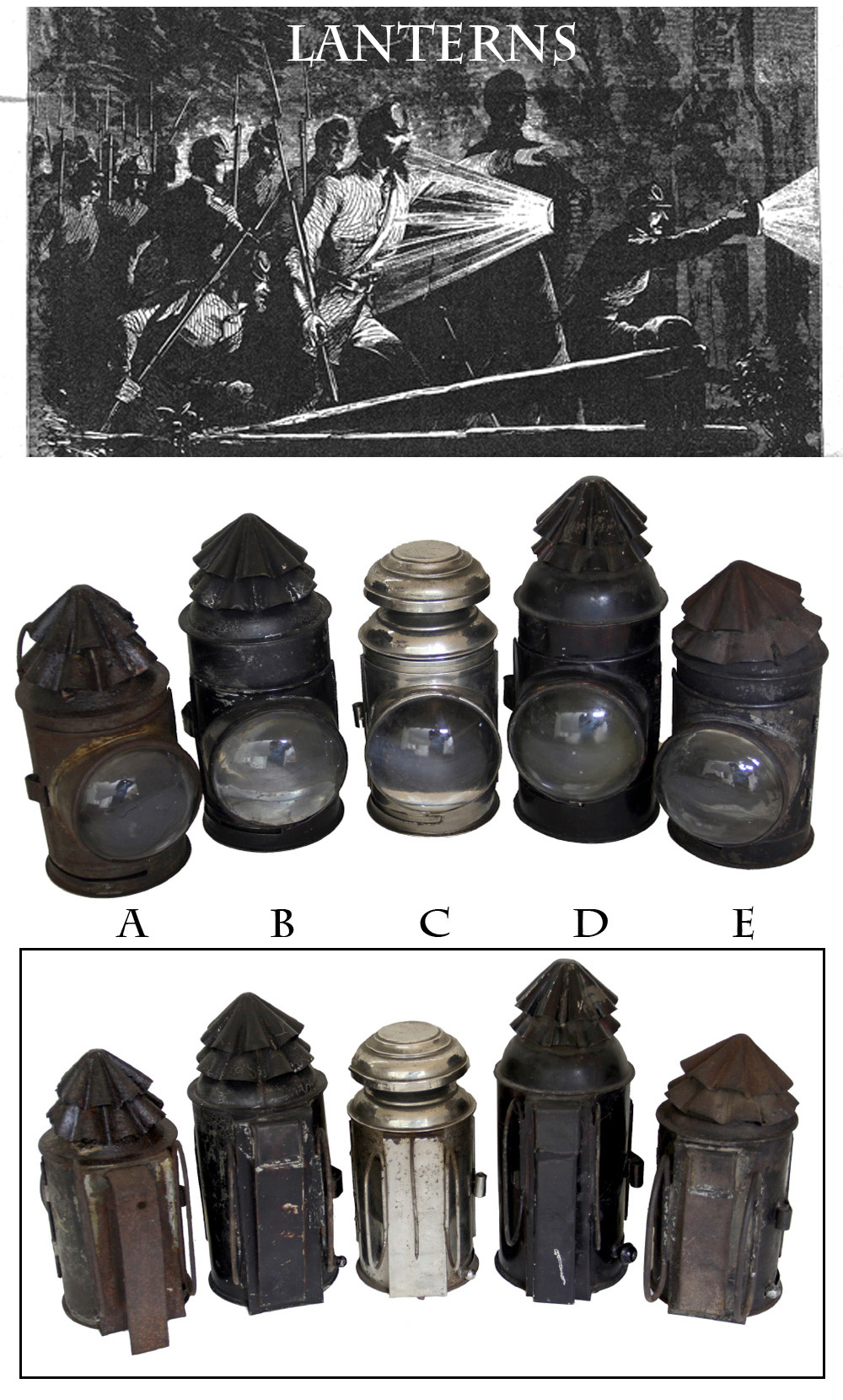
15-08-71-A … “I Am Looking For An Honest Man” …
Perfect for reenacting Diogenese the Cynic … Or Civil War times as well. Five “bulls-eye” lens lanterns, all dating to the last half of the 1800’s, most likely 1870s to 1890s, but perfect for Civil War living history or camp display. Each is fitted with bracket on the reverse so it can be fixed in place and is also equipped with folding wire carrying handles so that it can be held in hand and used like a modern flashlight. The bulls-eye lens was designed to focus the light in a beam and the lanterns are pictured frequently in the hands of police investigating suspicious night time activities, but also mounted on carriages, used for camping and the outdoors, etc. A Japanned tin, double-parasol top, bracket and handles in place, glass good. Light surface rust, gray underneath. No burner inside. You can use a candle … be
… $69.00
15-08-71-B … Lantern …
As above but with better surface of black paint preserved. Complete with burner … be
… $79.00 – SOLD
15-08-71-C … Lantern …
As above, but bright steel finish with circular flattened knob top. Complete with burner … noco
… $79.00 – SOLD
15-08-71-D … Lantern …
As above. Similar to “B” with smoother black finish and less flaking. Complete with burner … be
… $79.00 – SOLD
15-08-71-E … Lantern …
As above with black finish over gray tinned iron. Some flaking, but light rust only the vent covers. Complete with burner … be
… $79.00 – SOLD
Click Here to E-mail Us!
Call us @ 419-842-1863

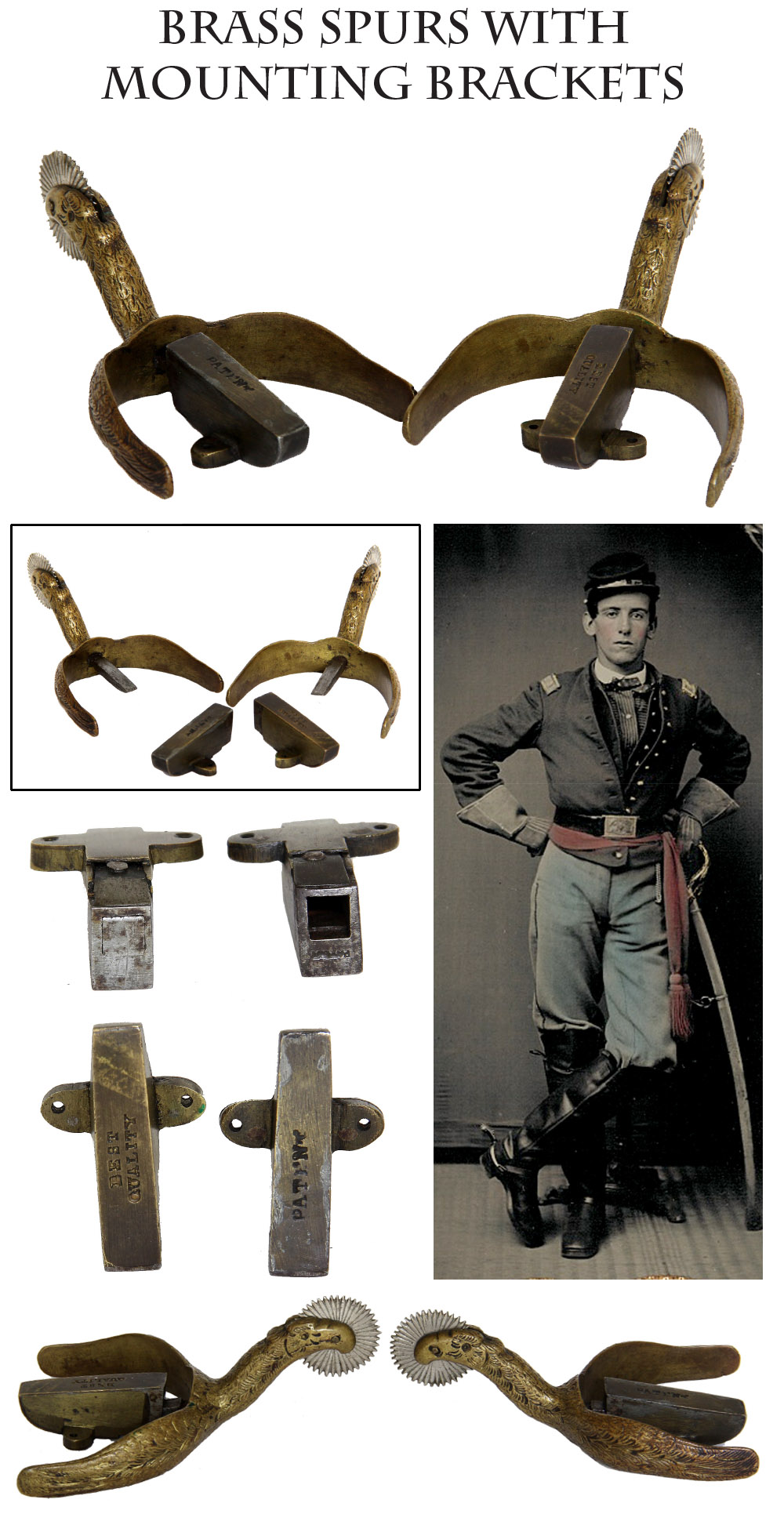
15-08-72 … Rare and Attractive Eagle-Head Spurs …
Way, way cool eagle head patent box spurs. These spurs were intended to be detachable and avoid the inconvenience of spur straps. Small boxes were inlet into the heels of boots and screwed in place. These then received and secured the central bars of the spurs, which in this case were cast and chased in the form of long-necked eagles with sunburst rowels in their beaks, their wings spreading rearward to form the spur sidebars. This set has both the spurs and the boxes, which are usually missing, the boxes being stamped “patent” and “best quality.” One box lacks an internal locking spring, otherwise complete. The Schuyler, Hartley and Graham 1864 catalog illustrates a set of “patent box spurs” for sale, but theirs are plain. This set was obviously a higher grade and was likely brilliantly gilt when new. No damage to the wings or rowels, nice detail on the chasing of the feathers. Overall a nice mellow suntan age patina. A great set for display with cavalry officer’s gear or mounted officers of infantry, artillery and other services. I gladly paid $1000 for these and am marking them up only marginally. These came out of the renowned collection of the late Gary Bisacky. … noco
… $1,295.00 – SOLD
Click Here to E-mail Us!
Call us @ 419-842-1863
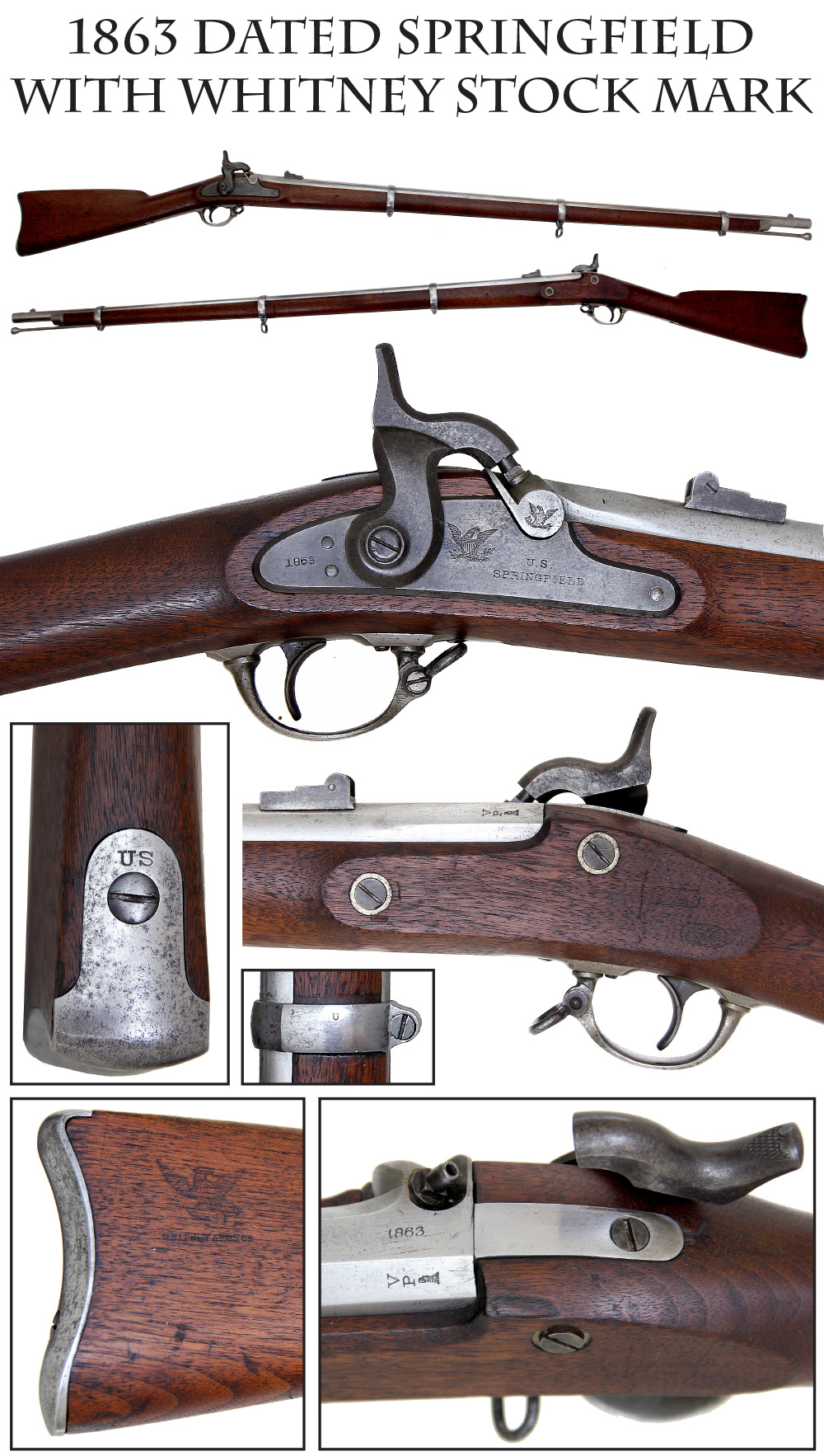 w
w
15-08-73 … 15-05-121 … Minty 1863 Type-1 Springfield Rifle Musket – Whitney Assembled …
A near mint ’63 Springfield. 100% original, 100% complete, mechanically perfect. All markings, cartouches, etc are vivid and crisp. Bore is new. All parts are excellent to near mint. On the right side of the butt stock is impressed a federal eagle and the wording Whitney Arms Co. This tells us that this musket was assembled by Whitney using Springfield parts. This gun is 100% Springfield from muzzle to butt plate. The Whitney mark shows that it was not assembled at the US Armory. After the war Whitney Arms bought wagon loads of Springfield parts and assembled them for sale on the commercial market. The gun is a dead real Civil War Springfield musket in all respects, just assembled outside the arsenal … ron-o-wbbjj
… SOLD
Click Here to E-mail Us!
Call us @ 419-842-1863

15-08-74 … Pre-War of 1812 Pennsylvania Officer’s Commission …
Professionally matted and framed early American officer’s commission for Joseph Bell, signed by Governor Snyder on the upper left corner, commissioning Bell as a Lieutenant in the Third Company of the 76th Regiment of Pennsylvania Militia in 1811. Slight separation line and two stains along the horizontal fold, but all very legible and nicely presented. Pennsylvania had an interesting militia history given its Quaker roots. Early units called themselves “Associators” rather than admit to military inclinations. Here is a nice example of an early Federal period commission granted on the eve of the “Second American Revolution” as some termed the 1812 war with Britain. A copy of the Governor’s biography is attached to the back and there might be some interesting material to be developed on Mr. Bell. Nicely presented and ready to impress visitors. Bbex-hilb … bbe-qq
… $375.00 – SOLD
Click Here to E-mail Us!
Call us @ 419-842-1863
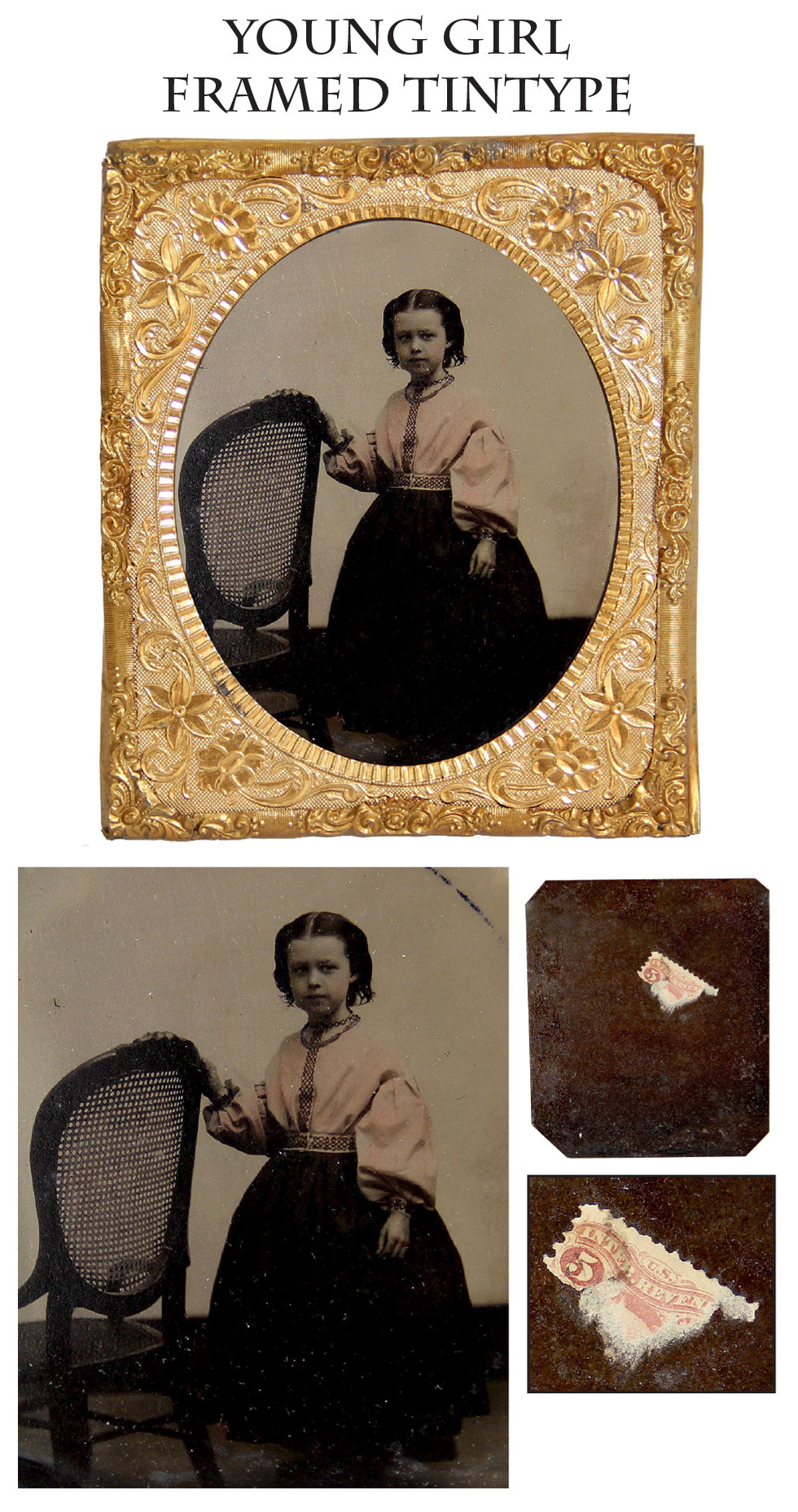
15-08-75 … Daddy’s Little Darling Waiting at Home …
Delicately tinted sixth-plate tintype of a pretty little girl posed standing next to chair with one hand on the backrest. Her expensive blouse with puffy sleeves has been tinted a light pink to match her cheeks, which the photographer also lightly touched up. Wonderful clarity and a plain background that highlights the subject. Comes with its original mat, but no glass. It would look wonderful cased. A partial five cent tax stamp on the reverse shows the image was made between the Fall of 1864 and the Fall of 1866 when certain goods were taxed to raise money for the war. No identification, but a hauntingly pretty image that would have carved a deep ache into the heart of any father at the front remembering his family and this little girl at home. A lot of punch for the money … cj
… $50.00 – SOLD
Click Here to E-mail Us!
Call us @ 419-842-1863
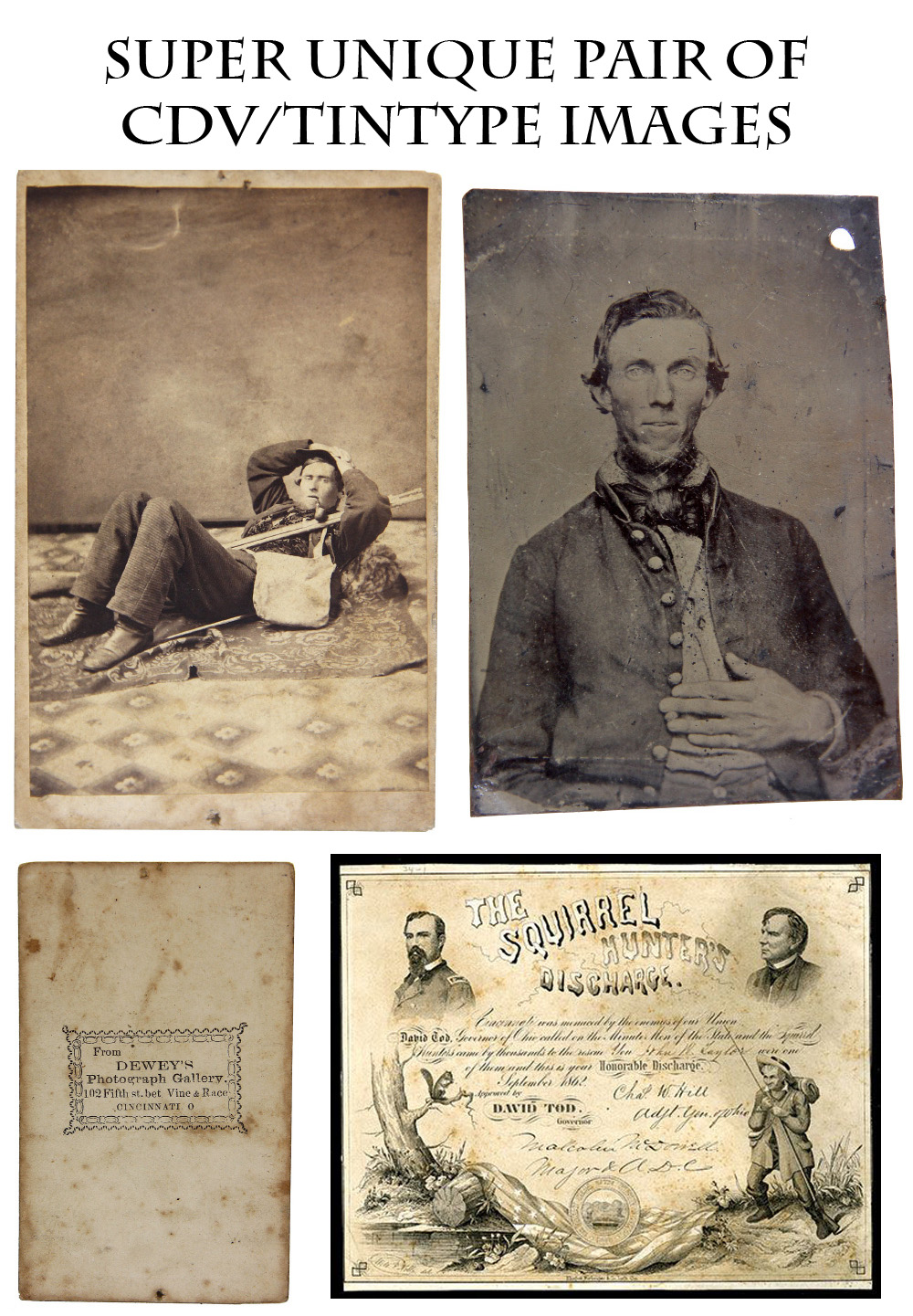
15-08-77 … CDV / Tintype “Ohio Squirrel Hunter Who Later Enlisted in the Army …
In late summer 1862 when Confederates seemed on the verge of striking from Kentucky into southern Ohio and seizing Cincinnati, emergency calls went out for men to defend the state. Some 15,000 men, members of militia, home guards and private citizens, hurried to the front and from their rather rag-tag appearance were nicknamed “squirrel hunters,” a label they took with pride. They obtained pay from the state and they were issued handsome official discharge certificates bearing a woodcut of a Squirrel Hunter in buckskins. The documents are highly sought here in Ohio. I obtained both images as one lot at auction in Cincinnati. This significant pair of images show the same man, the first in a Cincinnati backmarked CDV that likely shows him as a member of the “squirrel hunters” . As was typical of the hastily assembled force, he is wearing a mix of civilian and military clothing, informally posed lying down in a studio with his hands folded on his head, smoking a pipe, and cradling a military 1842 musket. The brim of a forage cap is plainly visible pushed back somewhat away from his face and a typical western “Cincinnati Depot style” unpainted white haversack hangs across him. His blouse may be a four-button fatigue blouse or sack coat, and what might be the blade of a bayonet runs out from under the haversack. If the coat is a US issue 4-button then we can make a case that our man is a full fledged state volunteer, as opposed to a Squirrel Hunter. His civilian vest and pants, however, tend to give strength to the Squirrel Hunter theory. In either event it is a hell of a Civil War soldier CDV. Poses of reclining soldiers are very rare. The second image is a tintype apparently of the same fellow, appearing a bit older and quite a bit less well nourished posed in his US issue infantry frock coat. While his name is lost to history the photos make a pretty good case that we are looking at a man who rushed to the front to defend the state in 1862 as part of the emergency force and then signed up to go south in the state’s volunteer forces in the field. A scarce bit of history recorded in just two photos and a story that might have been lost with their separation
… $595.00 – SOLD
Click Here to E-mail Us!
Call us @ 419-842-1863
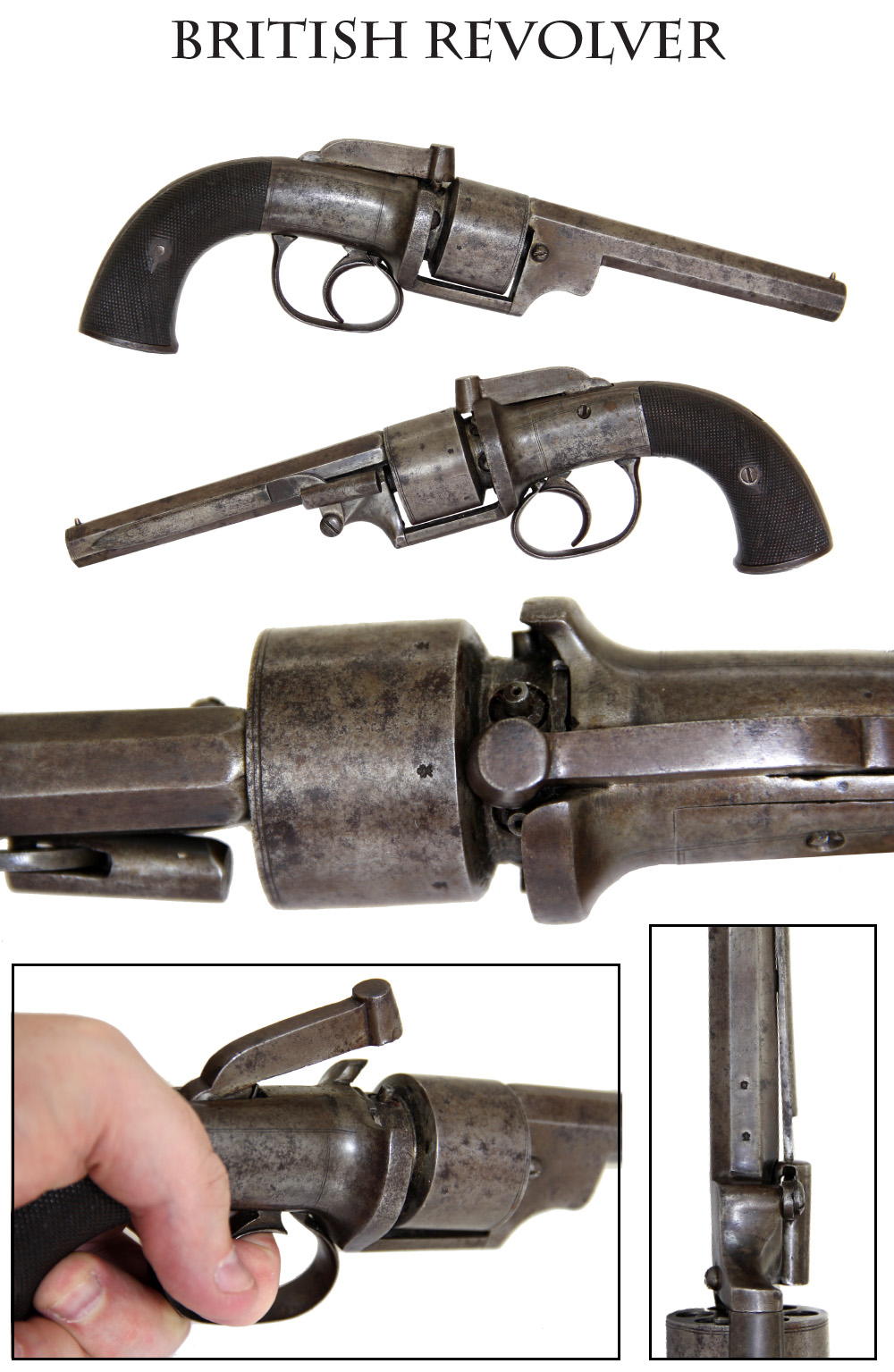
15-08-78 … Six Shot British Transition Revolver …
These double-action revolvers with a bar-hammer like you find on the multi-barrel pepperbox revolvers are called transition revolvers for a reason. They are the transition between the true pepperbox and the later Colt style revolvers. These are essentially short pepperboxes with barrels attached. They have a certain esthetic appeal. As with the pepperbox the trigger pressure necessary to fire it made it difficult to hit what you were aiming at, and it “might fetch something else” as Mark Twain put it. This has nice, typically British, tightly checkered grips, and a Kerr style rammer on the left side. British view and proof marks are visible on the cylinder and underside of the frame. About .36 caliber with 5 inch barrel. Mechanically functional, nipples not pounded down. Smooth metal, no pitting, overall gray in color with tones here and there of faded original blue and some hints of case on the hammer. Probably about 1850 to 1855, a rather sleek, elegant handgun that is an interesting part of the history of revolving arms … djj-17067
… $750.00 – SOLD
Click Here to E-mail Us!
Call us @ 419-842-1863
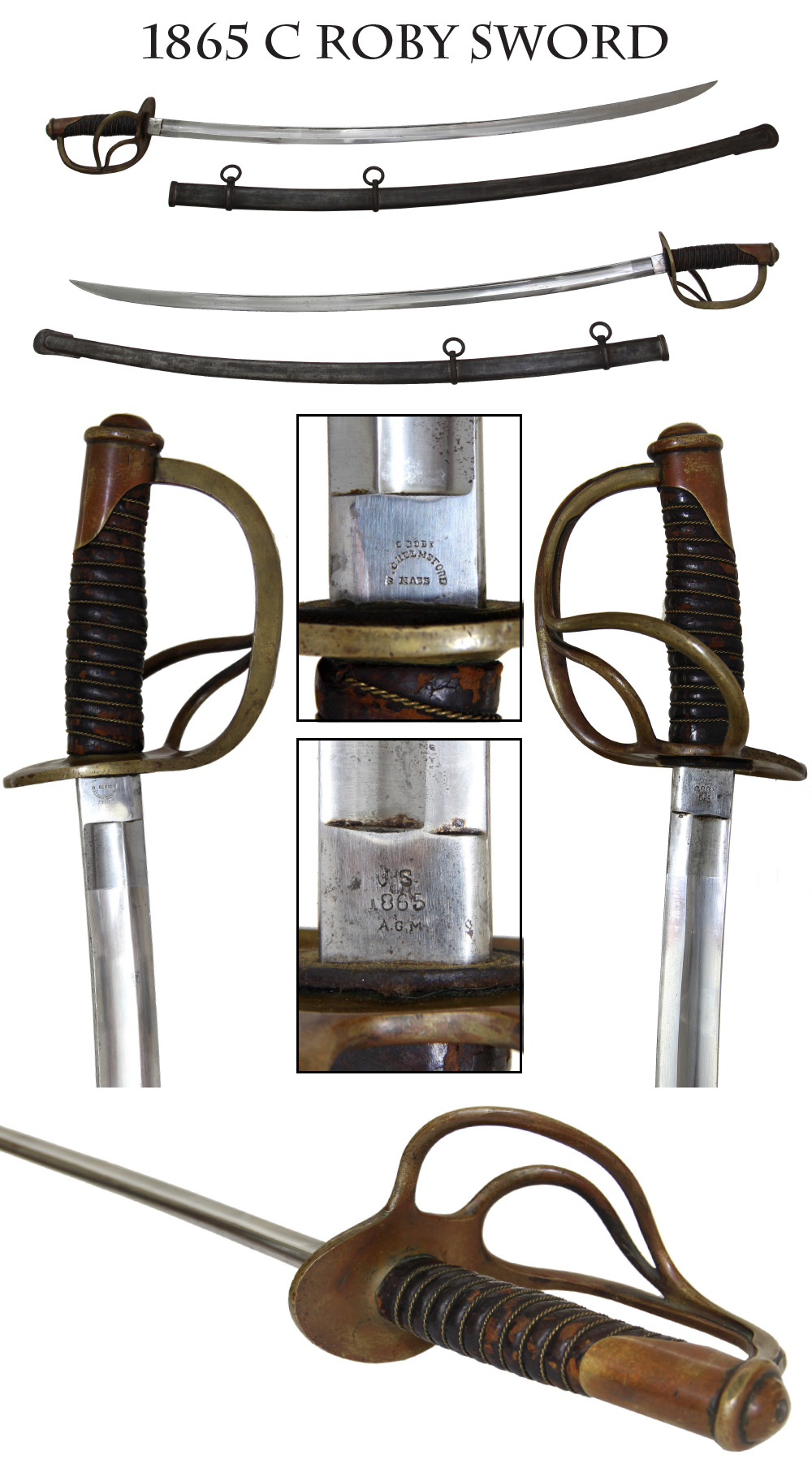
15-08-79 … 1865 Dated Roby Light Cavalry Saber, Mint Blade, Just Like Custer’s! …
Very nice regulation US 1860 pattern light cavalry saber made by Roby in 1865 showing nearly all the factory luster and also the original cross-polishing at the ricasso. An important indicator of condition on cavalry sabers has always been to look at the ricasso. As part of the finishing process the blade was polished cross-ways at this point and long-term use or refurbishing usually removes this. This saber shows it from ten feet away, making clear it is was put away unissued. The blade is spanking bright with crisp Roby maker marks and US AGM inspector and date marks. There are just a few light gray age spots near the top and bottom edges of the blade, the rest approaches a mirror finish. The original leather and full wire wrap are present, showing just some light age wear. It has flaked in a few spots. I have not dressed this up at all. The brass has a wonderful, undisturbed aged patina, the leather pad is in place below the guard, and the scabbard is an aged darkened bright steel that is free of dents or dings and now shows as a dull silver mixed with darker gray. This is a nice, untouched example of Civil War cavalry saber that was put away new and not messed with for 150 years. They don’t turn up this way very often any more. Roby is one of the prime suppliers of sabers to the government and this would be a great addition to a Civil War cavalry collection. Custer’s Roby saber is well known. His is dated 1864. A dandy example with TOP SHELF blade … ejj
… $950.00 – SOLD
Click Here to E-mail Us!
Call us @ 419-842-1863
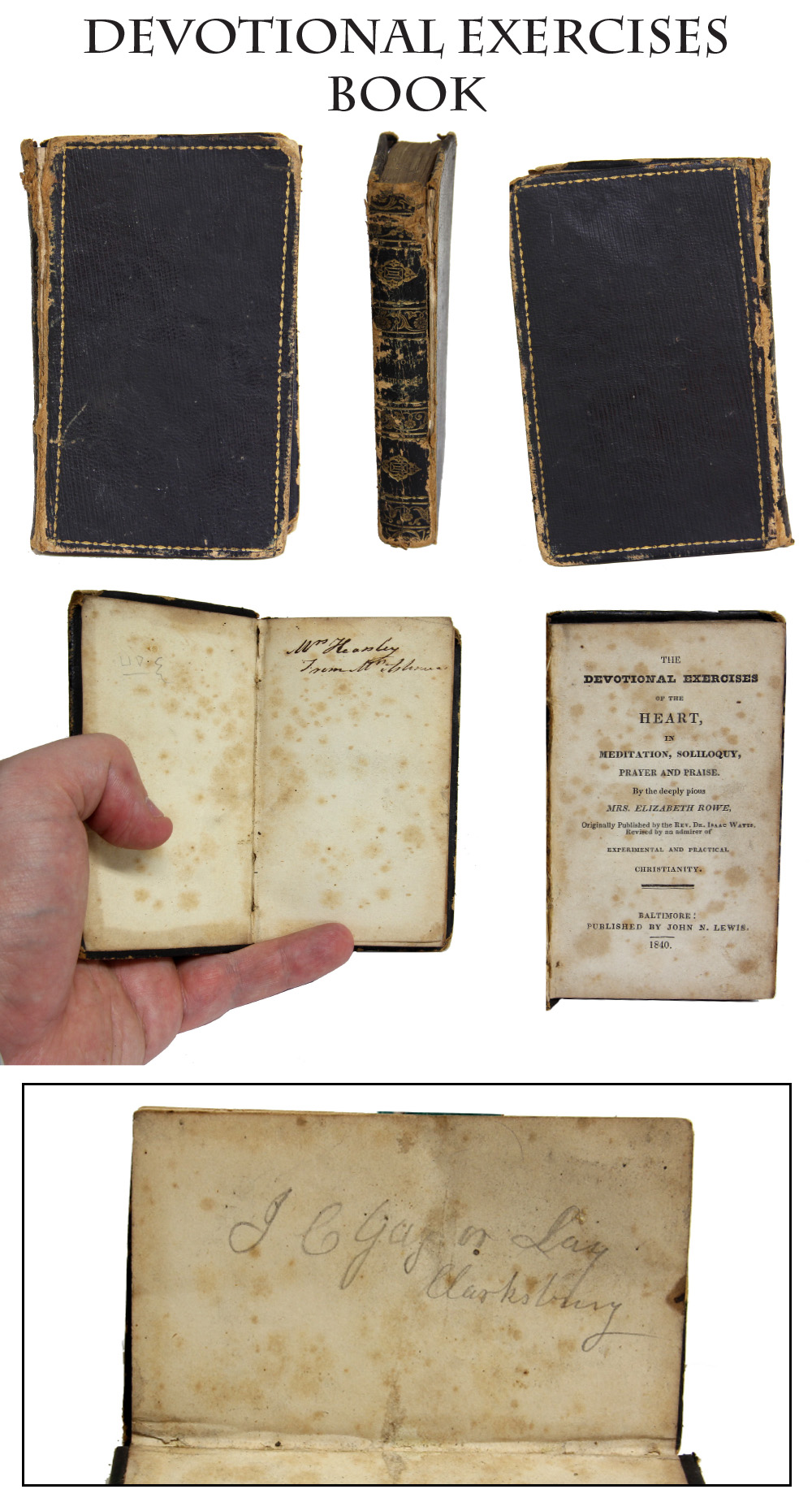
15-08-80 … Inscribed Baltimore 1840 Hymn Book …
Small religious pocket book titled “The Devotional Exercises of the Heart…” Leather bound, scuffing and some separation along the edge of the cover. Published in Baltimore in 1840. Small ink inscription on the flyleaf and then another pencil inscription “JC Gay or Lay/ Clarksburg.” Given that the writer of the second inscription was unsure of the name and seems to have been reading it on something else, it looks like the book was taken as a souvenir. It’s pointless to go much further in speculation, but the publication date makes it appropriate for an early western expansion, frontier and traveler’s display as well as a “go along” with a Mexican War or even Civil War display of soldier’s effects
… $45.00 – SOLD
Click Here to E-mail Us!
Call us @ 419-842-1863
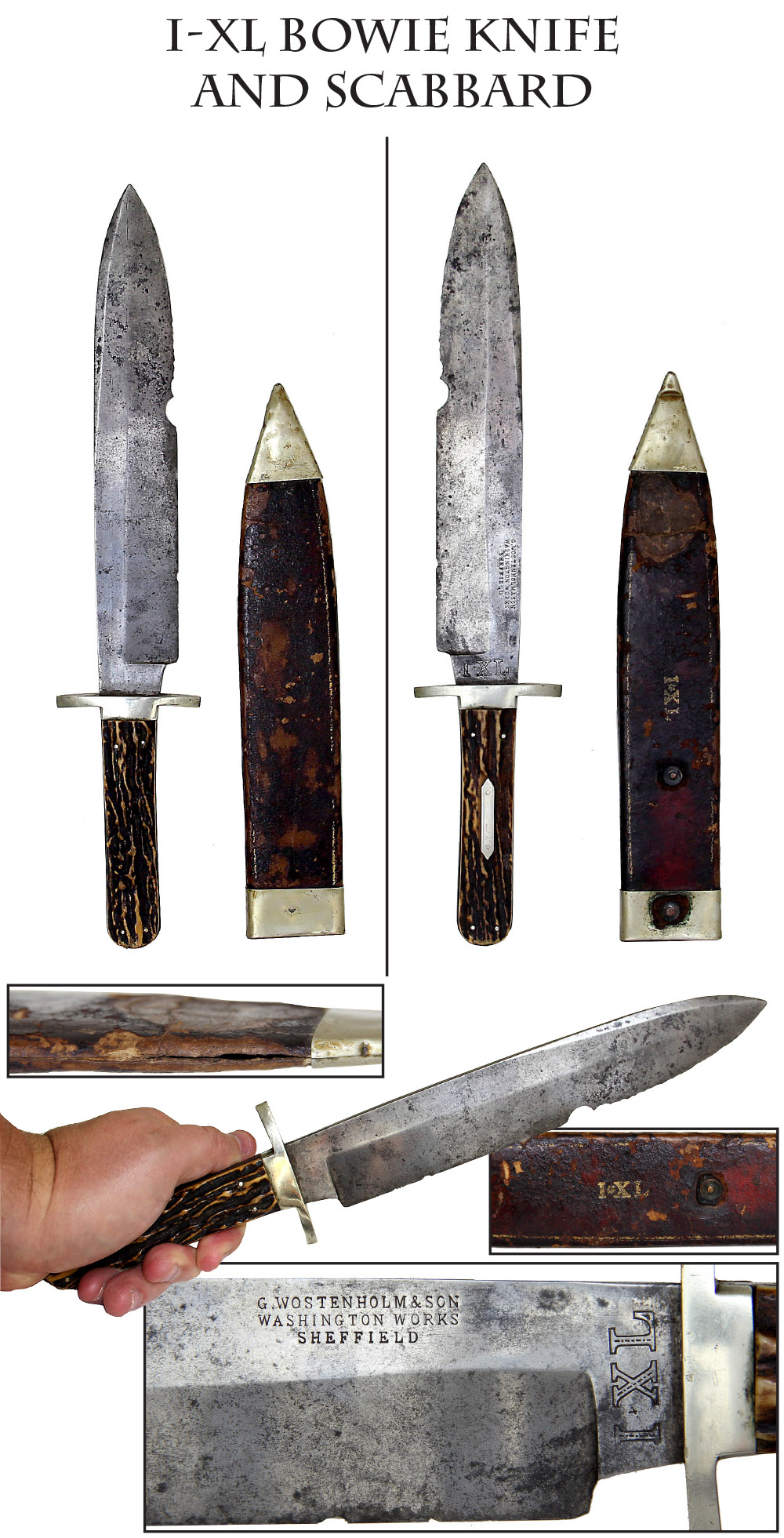
15-06-81 … Massive 1860 I-XL Bowie Knife …
A giant 1860s fighting knife measuring 15 inches overall in the sheath… perhaps the largest Bowie Knife I have owned… MUCH larger than the famed Rio Grande Camp Knives of the same pattern. Made and marked by “G. Wolstenholm & Son/ Washington Works/ Sheffield” with their mark on the upper left side of the blade and the “I-XL” mark on the ricasso and matching gilt blind-stamped mark on the sheath. This is a hefty utilitarian frontiersman’s and soldier’s belt knife with German silver mounts: oval-section flat crossguard … inset escutcheon panel in the left slab of the grip … german silver throat and tip on the scabbard. Minor seam opening on the leather covered pasteboard scabbard, some wear and loss to the leather, but complete and solid with much of the gilt embossing left. Rivet on the upper part of the scabbard and at the throat shows the owner did away with the small button stud seen on some knives and chose a sturdier belt loop, which is now gone. The massive blade is solid and has a large chip about 1/3 down from the tip, two smaller notches, and a little roughness to the edge toward the tip. There are also numerous dark spots mixed with the silver gray overall. This is an impressive Bowie with a substantial back edge leading from the spearpoint and would look great with a frontiersman’s or soldiers outfit from the 1850 to 1860s period. The Rio Grande Canp knives bring many thousands only because of the reference to the river in Texas in their logo. This is a better knife. This is a bigger knife. This is a good value on an antique Bowie
… $2,495.00
Click Here to E-mail Us!
Call us @ 419-842-1863

15-08-82 … Unmarked Brass Revolver:
I have no idea what this is, but I LOVE it. Brass frame, brass barrel, undisturbed patina… 2 1/2″ barrel … Belgian proof marks … looks like a .32 cal. rimfire
…
I have never seen another.
Overall VG … $895.00 – SOLD
Click Here to E-mail Us!
Call us @ 419-842-1863
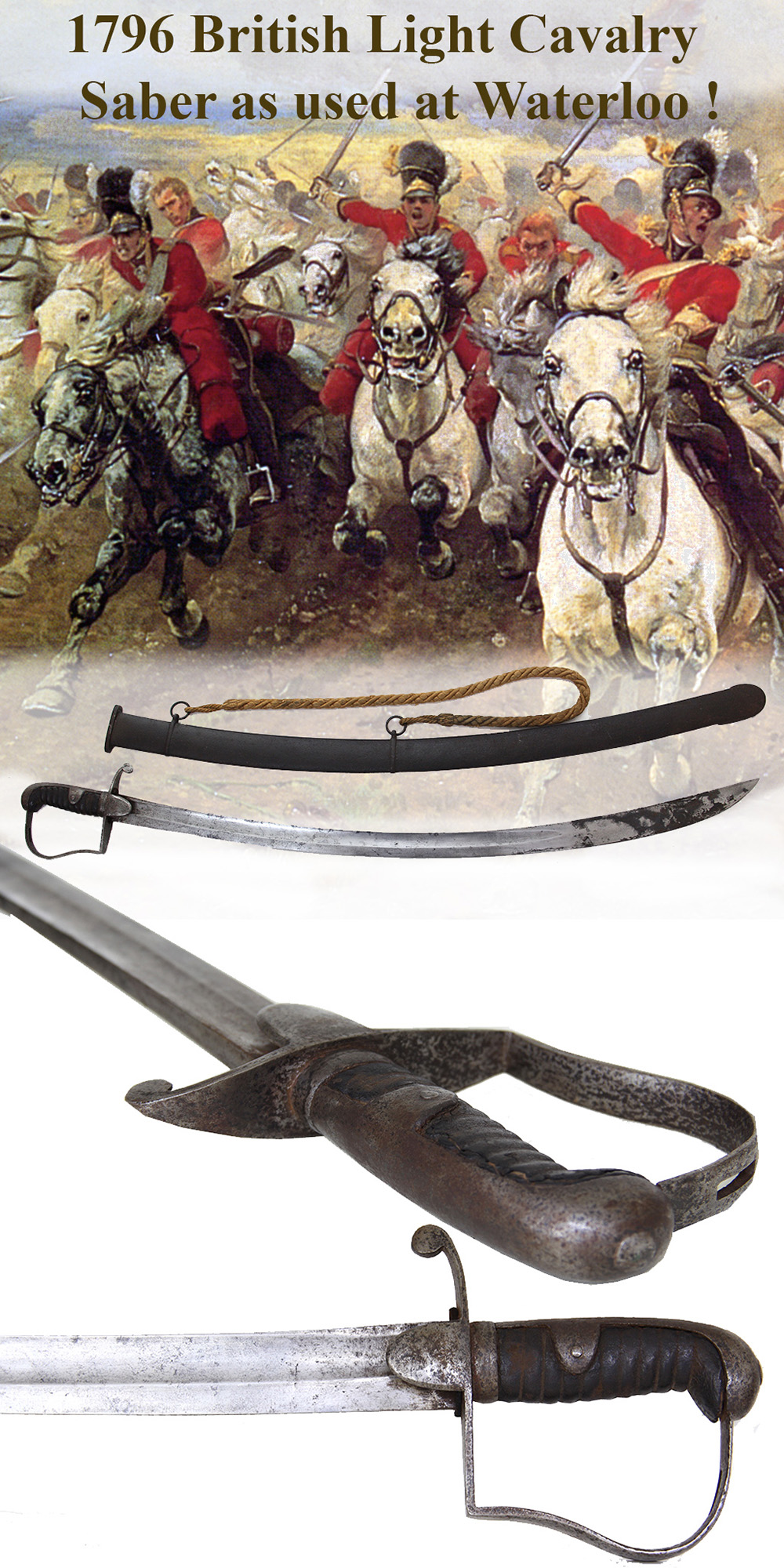
15-08-83 … British 1796 Pattern Light Cavalry Saber as Used at Waterloo …
It seems odd to call these substantial sabers light cavalry weapons, but they are distinct from the straight-bladed swords intended for the heavy cavalry and were a result of the fad for light troops, both infantry and cavalry, and are sometimes called Hussar sabers, after the well known Polish cavalry. This one is unmarked but shows all the signs of the typical British version that became regulation in 1796 and was widely copied, first by the Prussians then by we Americans as well. Iron mounts: stirrup guard with langets, birds head pommel with backstrap and ears, ferrule at base grip. Leather grip wrap is all there,the wire binding is long gone, but could be redone. Washer in place at blade shoulder. Blade has a good edge and is about 80% bright mixed with silver gray, but with some substantial dark areas near the tip from moisture settling in the scabbard. Some brown spotting to the guard as well. Typical brown iron scabbard with drag, carrying rings and substantial throat. The blade widens a bit toward the point to give a chopping edge to it that would be remembered by anyone on the receiving end of things. Someone added a braided cord to hang it and show it off. Fresh from a local auction where I bought it for dirt
… $545.00 – SOLD
Click Here to E-mail Us!
Call us @ 419-842-1863

15-08-84 … Very Rare French Officer’s Saber for an Officer of National Volunteers under the Constitutional Monarchy of 1789-1792.
An extremely rare sword from the days of the French Revolution. Missing the elaborate guard that shows Athena and the triumph of the revolutionary ideology, but retaining the even scarcer original scabbard and worthy of restoration. Or if you need an original scabbard I dare say this is the only one on the market this year. Characteristic knights helmet pommel in place. Blade is bright mixed with gray and dark spots but showing very clearly the engraved martial motifs on both sides which retain most of their gilt fill. Good edge without nicks. Wire and some of the copper tape is present on the grip, wood is sturdy, but leather wrap should be redone. The scabbard is exceptionally rare: the leather is in very good condition, middle mount gone, but the drag and upper mount with carrying ring are present. This sword is a very scarce blade from the beginning of the French Revolution and the many wars and conflicts that followed, which threw Europe into turmoil. Swords with damaged or broken blades sometimes show up with good guards and this would be well worth acquiring to keep on hand to complete a restoration
… $575.00
Click Here to E-mail Us!
Call us @ 419-842-1863
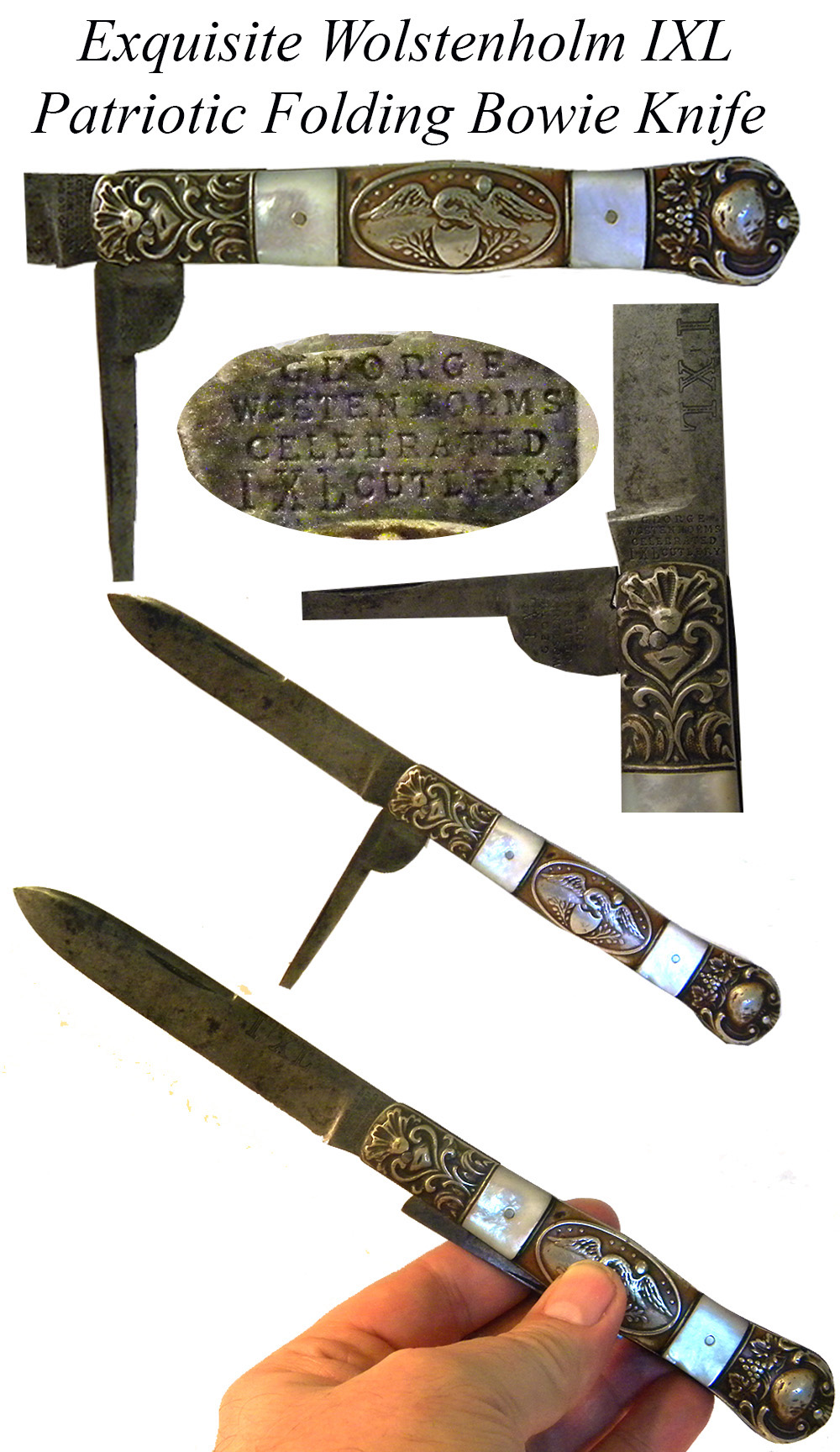
15-08-85 … Wolstenholm IXL Patriotic 2 Blade Folding Bowie Knife: …
Superb large (9 inches overall) silver mounted IXL folding Bowie Knife. Two bladed affair… main blade and an awl or punch. Tip of punch blade is broken off. Nicely marked with full George Wolstenholm firm marking and IXL brand which is of course a play on the words ” I Excel ” —- IXL. Shows expected wear and use but no abuse. Has classic American eagle motif on the central panel of the handle which is accented with mother-of-pearl insets flanking the eagle. Solid, rare, and very desirable in this large size. These were made 1850s into Civil War years and not after. A dandy patriotic knife
… $1,450.00 – SOLD
Click Here to E-mail Us!
Call us @ 419-842-1863

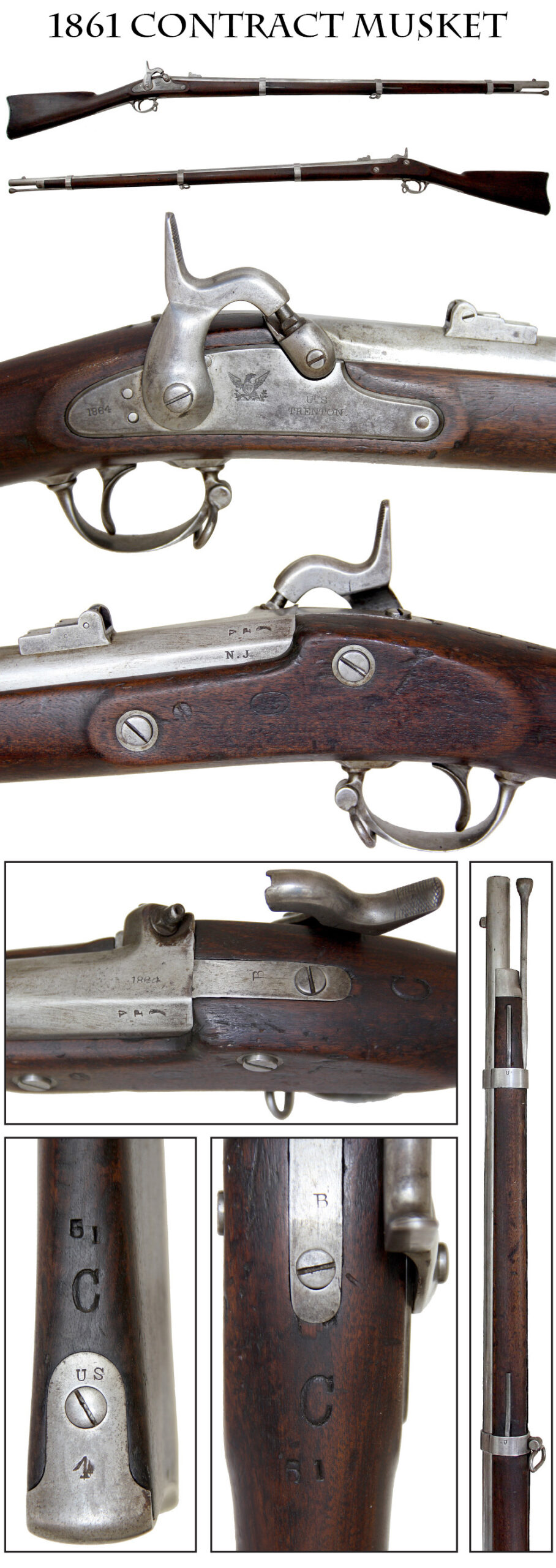
15-08-86 … New Jersey Marked Model 1861 Springfield Contract Musket / TRENTON …
A Very Good to near fine example of the standard Union Army infantry weapon, produced by Burt and Hodge at the Trenton Locomotive and Machine Company. A.M. Burt and J.T. Hodge were partners in leasing the Trenton New Jersey facility to produce Springfield Model 1861 rifle muskets for the US government and the state of New Jersey, on contracts taken in each of their names. This is one of the NJ guns. Crisp 1864 date rear of lock, eagle and U.S. / Trenton forward. and matching 1864 barrel date, crisp V/P/eagle proofs left barrel flat. Metal is smooth grey steel overall with sharp markings. Area around bolster is excellent, screw slots fine, Wood edges are sharp and show only mild handling wear. Super wood-to-metal fit. Bands, springs, rod, swivels, etc., all correct and in place. Barrel stamped NJ and stock cartouched NJ still lightly visible shows purchase by the state of New Jersey for her troops. Numerous rack or unit markings on the butt and butt plate tang. Very strong condition overall. It is a solid example of a midwar contract rifle-musket that soldiers were glad to get to replace the early war European “fence rails” they had had been using to kill each other with earlier in the war. It will display like gangbusters with a good belt set and cartridge box rig. A very fair price for a gun of this quality. ae-grif
… $1,795.00
Click Here to E-mail Us!
Call us @ 419-842-1863
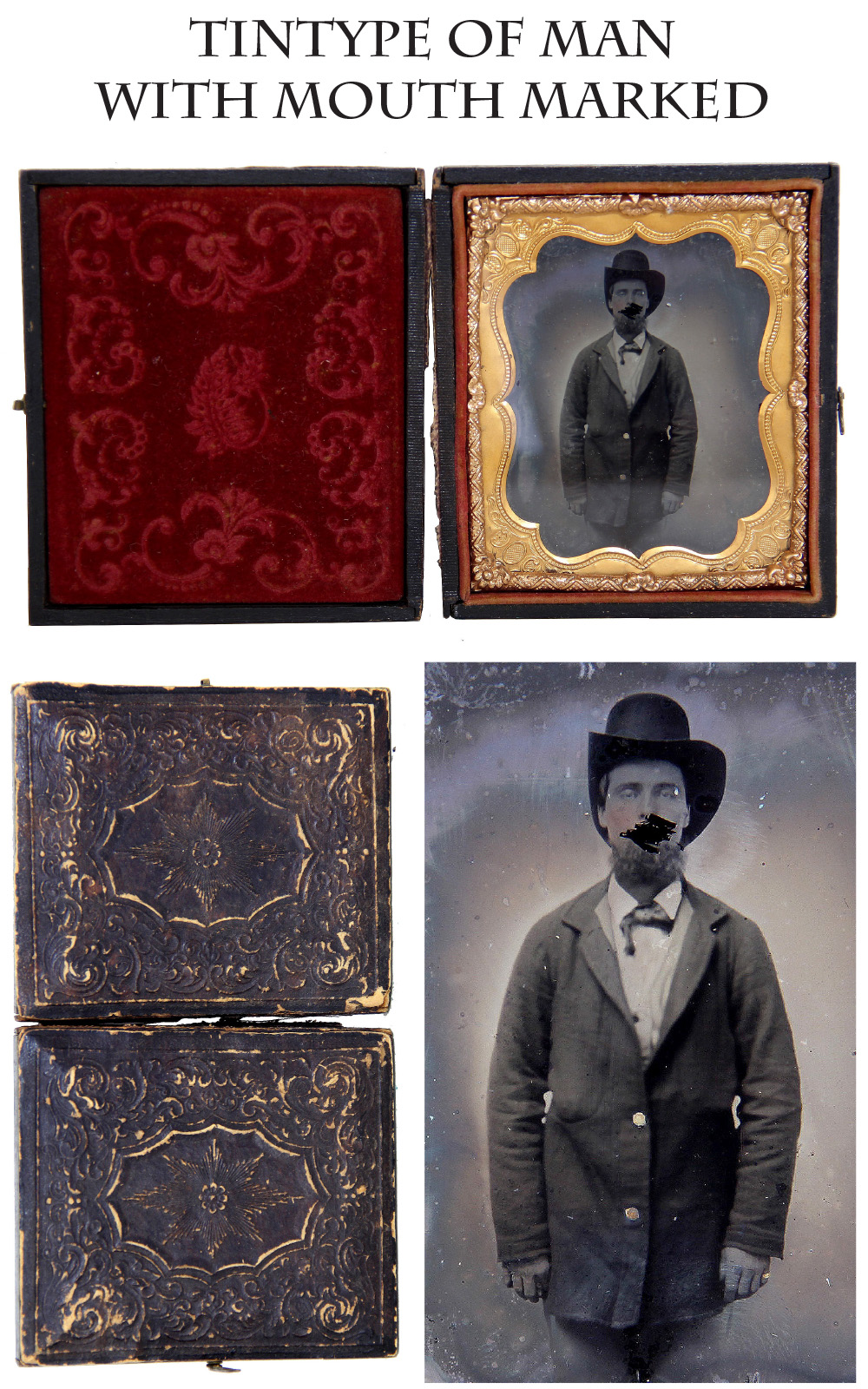
15-08-87 … I Guess He Just Couldn’t Shut Up …
Clear sixth-plate tintype of a soldier in a lined four-button fatigue blouse and untrimmed hardee hat. He is wearing a civilian shirt and necktie visible under the opened blouse and seemed fairly well scrubbed, so it is tempting to think he is fairly new volunteer. There is a good deal of clarity and texture to the photo- particularly around the man’s hands, and the photographer has lightly tinted his cheeks and gilded the buttons. He has something bulky and odd shaped in his breast pocket. Between his chin and nose, however, someone has intentionally made several short passes to remove the emulsion and erase his mouth. Perhaps he was a bit too talkative or his wife decided to make a point about his recurrent use of profanity. I have owned images where portraits of married couples are later “defaced” with the woman’s face completely obliterated. I assume a divorce or affair was likely the cause of that defacing. Whatever the story is here, the image comes matted, framed and glassed in a leatherette case with a detached hinge and makes interesting conversation piece, so to speak
… $75.00
Click Here to E-mail Us!
Call us @ 419-842-1863

15-08-89 … Sharps and Hankins 4 Shot Pepperbox Deringer With Wonderful Blue …
Fine ++ condition Sharps and Hankins four-barrel “pepperbox.” This is the larger size with 3 inch barrels. These .32 caliber derringers allowed four shots by using a rotating firing pin that discharged each barrel in turn, and were handy pocket guns carried by soldiers, travelers, westerners, lawmen and gamblers. One was reportedly found on the body of Wild Bill Hickock, who tried to take as few chances as possible. This one is serial number 9023, which puts it about midway in the production run, but it also bears the Sharps and Hankins, Philadelphia barrel, address more closely dating it to the period of 1862-1866. The wood grips are likewise fine showing just a couple scattered dings. The steel frame is gray with some rumors of case color, and the Sharps patent stamp is clear. Trigger shows some case and the sights are in place. Mechanically good. Best of all is the barrel assembly showing 80 percent or better lustrous factory blue with just a little spotting toward the muzzle and some gray showing through midway on the lower right. A darn nice pepperbox … ffj-sorg
… $950.00 – SOLD
Click Here to E-mail Us!
Call us @ 419-842-1863

15-08-91 … Original Unaltered Full Length Very Early War or Pre-War Cavalry Carbine Sling …
Carbine slings went through a number of design changes. This one shows the earliest configuration: a straight line of stitching securing the buckle. This was eventually found by the ordnance department to be a weak point since the holes for the stitching formed a serrated line that could tear under stress. The next improvement was several lines of stitching running lengthwise and then the introduction of rivets. That is the style we usually see. This specimen is very early and very scarce. It is bridle leather and not only full length, measuring 56 inches, but one of the earliest I have had a chance to offer. Original roller and snap-swivel, original batwing belt tip in place. A few spots of abrasion and some alligatoring to the leather surface from actual use and wear, but a very scarce cavalry accoutrement when unaltered. (Most available now are rebuilt from original and reproduction parts.) If you are looking for a real, unmessed with sling that could have been in any of the wartime engagements, this is for you. I don’t think there is another one currently offered on the market … bjj
… $1,450.00 – SOLD
Click Here to E-mail Us!
Call us @ 419-842-1863
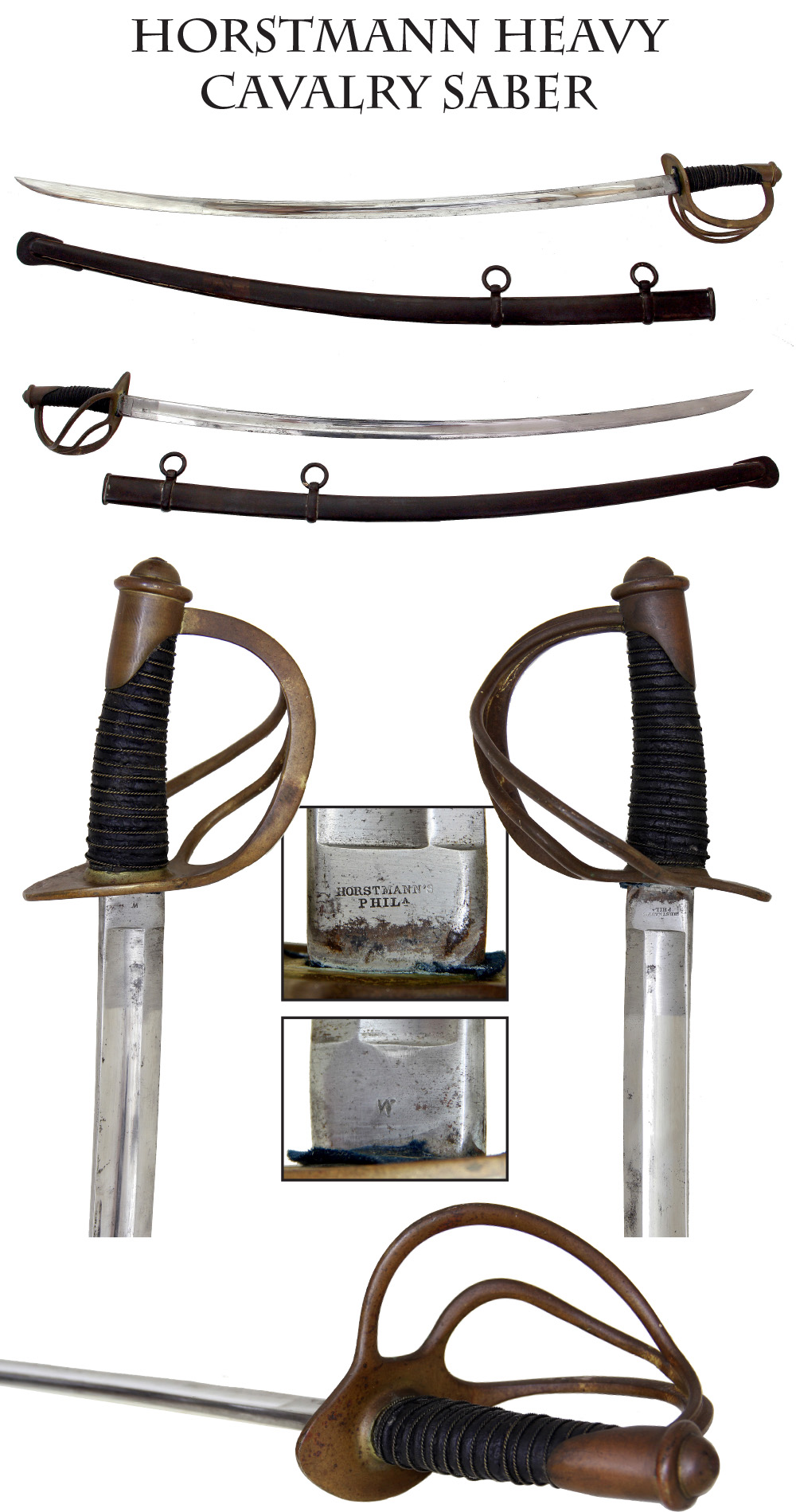
15-08-92 … Scarce Horstmann 1840 Type I Heavy Cavalry Saber and Scabbard …
Clearly marked on the ricasso is the revered name of Horstmann, one of the most prolific US military goods suppliers of the 19th century, who by 1864 had sold more than 25,000 swords to the US Ordnance Department, not to mention the tens of thousands they sold privately and to specific units. Their enlisted cavalry sabers followed the British 1822 pattern, the US 1840 or the US 1860. This is the scarce “Type-1” version of their 1840 pattern in Thillmann’s terminology, produced at the very beginning of the war using blades obtained from Emerson and Silver as a subcontractor to meet their early war contracts. In contrast to Horstmann’s imported sabers, the blade shows an odd wedge shaped stamp on one side of the ricasso and “HORSTMANN’S / PHILA,” on the other. It has the soldered throat (no rivet), and grip of turned wood under the leather rather than the cord-wrapped smooth wood of the imports. Ours has full leather and twisted wire wrap, with a little chipping on the leather and slight looseness on the twisted wire. The leather bumper pad is in place at the blade shoulder, and the blade is in exceptional condition with nearly all the original bright factory luster intact. On a scale or 1 to 10 the blade is a 9.7. The scabbard is overall smooth steel with age brown patina and some mottled age spots. The super blade is worth the price of admission
… $775.00 – SOLD
Click Here to E-mail Us!
Call us @ 419-842-1863

15-08-93 … Scarce Horstmann 1840 Type-1 Heavy Cavalry Saber and Scabbard …
Clearly marked on the ricasso is the revered name of Horstmann, one of the most prolific US military goods suppliers of the 19th century, who by 1864 had sold more than 25,000 swords to the US Ordnance Department, not to mention the tens of thousands they sold privately and to specific units. Their enlisted cavalry sabers followed the British 1822 pattern, the US 1840 or the US 1860. This is the scarce “Type-1” version of their 1840 pattern in Thillmann’s terminology, produced at the very beginning of the war using blades obtained from Emerson and Silver as a subcontractor to meet their early war contracts. In contrast to Horstmann’s imported sabers, the blade shows an odd wedge shaped stamp on one side of the ricasso and “HORSTMANN / PHILA,” on the other. It has the soldered throat (no rivet), and grip of turned wood under the leather rather than the cord-wrapped smooth wood of the imports. Ours has full leather and twisted wire wrap, with a little chipping on the leather. The leather bumper pad is in place at the blade shoulder, and the blade is overall VG to near fine. Nice smooth grey steel with quite a lot of shine. The scabbard is overall smooth steel with age brown patina and some mottled age spots. A good solid early war cavalry saber … djj-jq-01203
… $675.00 – SOLD
Click Here to E-mail Us!
Call us @ 419-842-1863
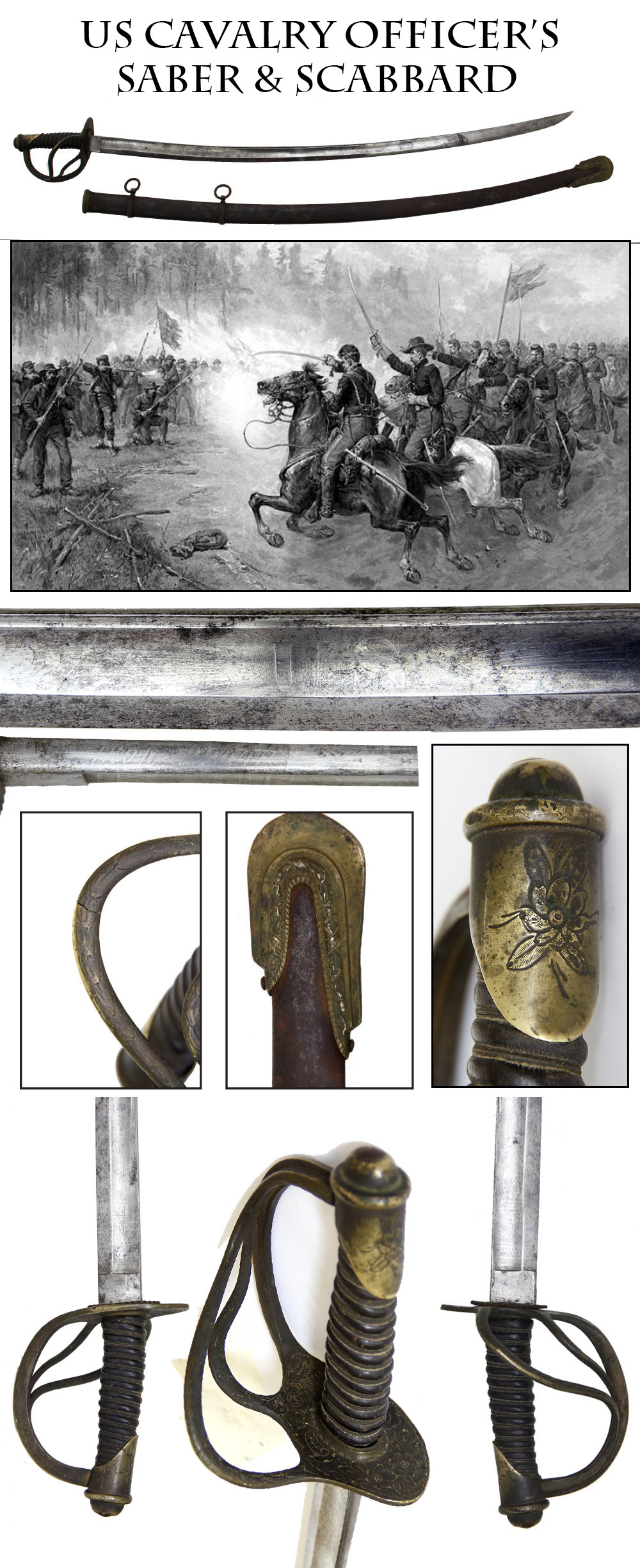
15-08-94 … US Cavalry Officer’s Sword & Scabbard …
Handsome, unmarked import Yankee cavalry officer’s saber with nice detail and hand chasing on the guard, with a US etched blade. “Iron Proof” blade etching on the spine near the guard, typical of German made swords imported here by American retailers in large quantities during the war. A robust saber modeled on the US 1840 pattern. Hilt retains full leather on the grip and rare dragoon style “piano wire” twisted wire binding. Nice age darkened patina to the brass hilt and mounts. Pommel has a floral motif on its face that carries over to the leaves cast in the guard branches and inside of the counterguard. One slight crack in the outermost branch about one third of the way along. Nice brass throat and mounts, and drag has a nicely cast serrated edge and bound vine motif. Scabbard blue has shifted to brown, now mixed with dark spots, but with no substantial dents or dings. Blade shows the light remnants of etching: floral and geometric motifs, the “US” surrounded by sun rays shows well on one side. Overall blade is a mix of dull silver and light gray with a few darker areas. It has a good edge and no pitting. Blade pad still in place at the shoulder. A very presentable mounted officer’s saber priced friendly … noco
… $1,395.00
Click Here to E-mail Us!
Call us @ 419-842-1863

15-08-95 … 1839 Dated Ames US Pattern 1833 Dragoon Saber …
The 1833 dragoon saber was modeled on the British 1822 light cavalry saber and introduced when the U.S. reinstated mounted troops in the U.S. army (after relying on state troops for cavalry after the War of 1812.) The new pattern had a quill-backed blade, brass guard with two branches, backstrap, flat bird’s head pommel, and a leather covered grip with twisted brass wire wrap and brass ferrule at the base. The leather grip is about 80 percent intact with some of the underlying wood showing through with a deep age patina. The wire is in place. “MPL/ ORD” ordnance stamp on one side of the quillon terminal disk, “WS” inspector stamp on the other. Legible and distinct blade markings: “NP Ames / Cutler/ Springfield/1839” engraved in script near the ricasso and matching “WS” inspector stamp at base of blade on one side, script “United States” over a wreath on the other. Leather pad in place at blade shoulder. Blade rates very good, with no edge damage and a mix of bright and dull silver tones with some darker gray areas. Scabbard shows mostly gray with dusty brown areas and some darker gray portions on the inboard side just above the drag. Throat, drag, and correct split rings are in place. There is a repair to a crease in the scabbard just north of the drag.
This was the regulation arm of the US dragoon regiments until the 1840 “heavy cavalry” style sabers were adopted, and for some time thereafter until the new pattern could be produced and issued. Even then, many of these remained in the hands of militia groups and made their way into early Civil War service. If you collect American swords or cavalry gear, this is one of the “must have” pieces. Priced as friendly as I can make it: these don’t show up often in any kind of acceptable condition any more… this one is darn nice … h
… $1,350.00
Click Here to E-mail Us!
Call us @ 419-842-1863

15-08-96 … Ultra Attractive American Eagle Head Sword …
Magnificent… as-found… beautiful eagle pommel sword, with lots of original gilt on the hilt and scabbard. The blade is near MINT condition. Bone grip intact… one longitudinal crack on one side… two inconsequential hairlines on the other,… solid and stable. Nicely formed curved neck eagle’s head pommel with plain backstrap and chain guard connecting to one of two pineapple finials on the cross guard, which is straight. The eagle is as ferocious and handsome as any I have encountered. The guard is faceted and has to two downward turned shell-shaped langets. Grip has geometric incised lines. Superb, wide, straight double-edged blade with oval cross section and central fuller. Vivid beautiful etching on a minty bright blade. Has the usual floral motifs with a great US eagle and stars above and Indian brandishing a bow and tomahawk symbolizing America. Gilt brass scabbard shows about 40 percent bright, the rest a darker untouched patina. Throat, drag and all carrying rings present. A very nice sword of about 1840-1860 that would show very well in an edged weapons collection. One of the prettiest eagle heads I’ve owned … bajj-eub
… $2,495.00
Click Here to E-mail Us!
Call us @ 419-842-1863
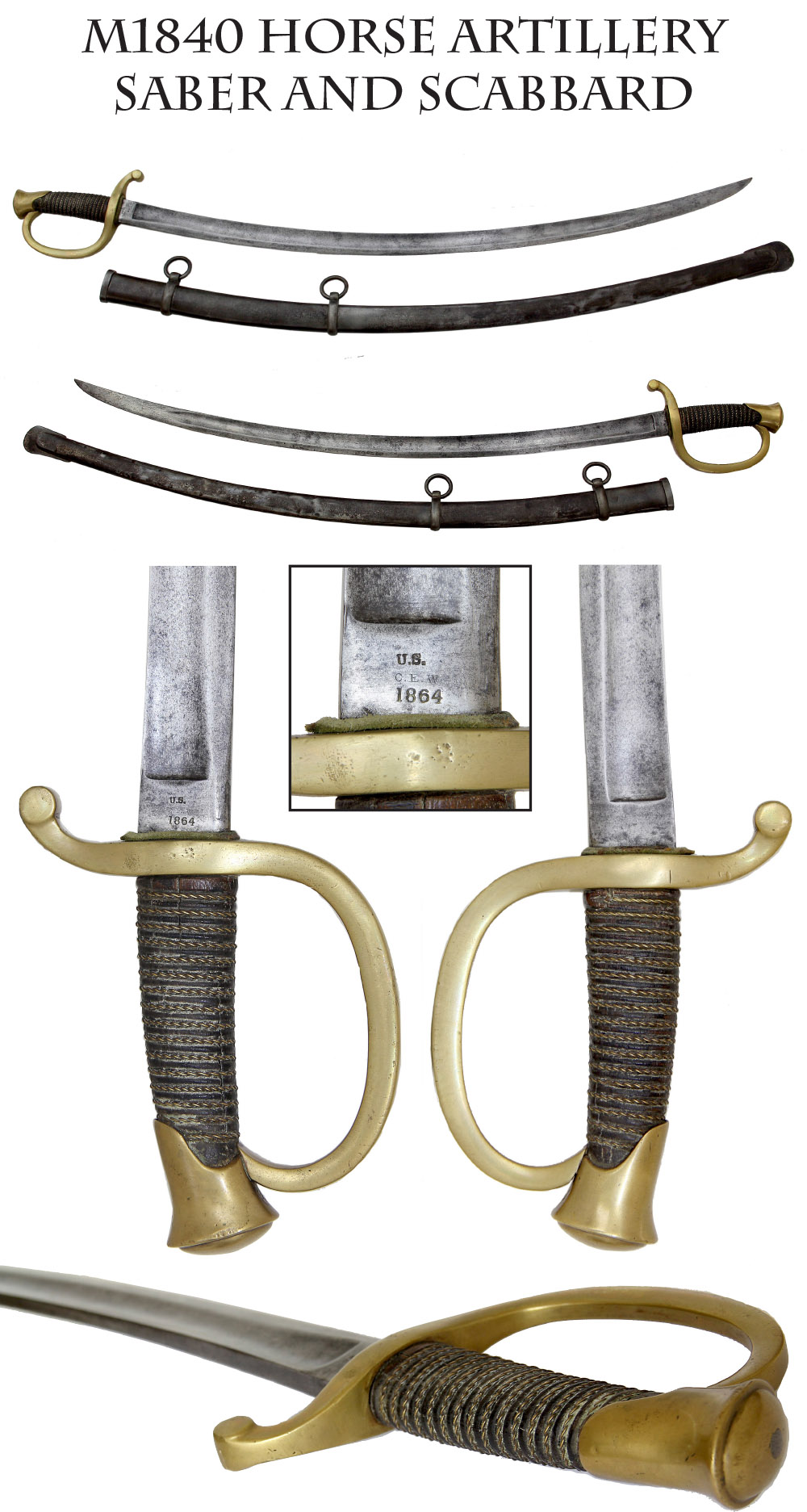
15-08-97 … M1840 Light Artillery Saber and Scabbard …
The light artillery saber was meant to offer the mounted drivers in light artillery batteries, and all personnel in horse artillery units, a weapon for personal defense. Here is an 1864 dated and inspected version certainly by Ames, though the Ames mark itself is too light on the ricasso to make out readily (the date and inspector marks are sharp- Ames scroll maker marks are notoriously light.) The grip leather and wire are good and tight, just a slight bit of wood exposed at the guard with an rubbed patina from the leather shrinking. The brass is medium in tone. The blade washer is in place. The blade has a good tip and edge. Bright mixed with silver gray overall. Scabbard is in the bright, with darker on the outboard side on the lower portions and overall on the left with a couple of small dents. Carrying rings and throat are in place… ejj-17067
… $785.00
Click Here to E-mail Us!
Call us @ 419-842-1863

15-08-98 … New Jesey Inscribed Officer’s Sword:
1850 pattern foot officer’s sword in a brass mounted steel scabbard. Matching mellow patina to all the brass- untouched with some dark areas. Down-turned pommel that suggests Sauerbier as a maker or dealer, but has a stopped fuller and sharkskin grip. Grip good with just wear and rubbing to high spots from use. Single thick wire binding, one small piece of a thinner bordering wire near the pommel. Scabbard silver gray turned brown for about two thirds the length. Brass throat, carrying rings and drag in place. Between the upper mounts is a separate brass shield shaped plaque held by a band, nicely inscribed: “Lieut. F. W. Sowby / Co. B / 1st N.J. V.V.” in Old English and block letters.
CWData shows two men named F.W. Sowby, but there was only one, serving in the 3rd New Jersey, and then joining the 1st New Jersey Veteran Battalion (or “1st NJ Veteran Volunteers”) which consisted of the consolidated units. Sowby enlisted in the 3rd NJ in April or May of 1861, mustering in as a private in Company B and making corporal as of July 1, 1863. He served with them until 6/23/64 when he and the others who had reenlisted as veterans or had time left to serve were transferred and he joined Company B of the 1st NJ. He was commissioned 2nd Lieutenant 2/2/65 and 1st Lieutenant 5/11/65, mustering out 6/29/65. Sowby would have seen a lot of action. Both units were Army of the Potomac, 1st and 6th Corps. The 3rd, in particular, took heavy casualties at Gaines Mill, Cramptons Gap, Salem Heights, and Spottsylvania during Sowby’s service, and the 1st saw action at Winchester, Cedar Creek, and Petersburg. The blade is a smooth silver gray, rubbed on one side, but with very visible etching and a nice eagle with E PLURIBUS UNUM ribband on the other. No maker or dealer markings, but a dead-real inscription and an interesting sword carried by a soldier who saw a lot of fighting … aejj
… $2,350.00
Click Here to E-mail Us!
Call us @ 419-842-1863
15-08-100-UP … Attic Brown US 1816 Bayonet …
The standard socket bayonet for the M1816 musket. Overall attic brown patina with some light surface pitting which is not noticeable as it is mixed with the brown. Deeply stamped US and SM on the ricasso. If you have a solid brown old musket, here is the perfect mate at a friendly price. no photo (a chuk)
… $139.00 – SOLD
Click Here to E-mail Us!
Call us @ 419-842-1863
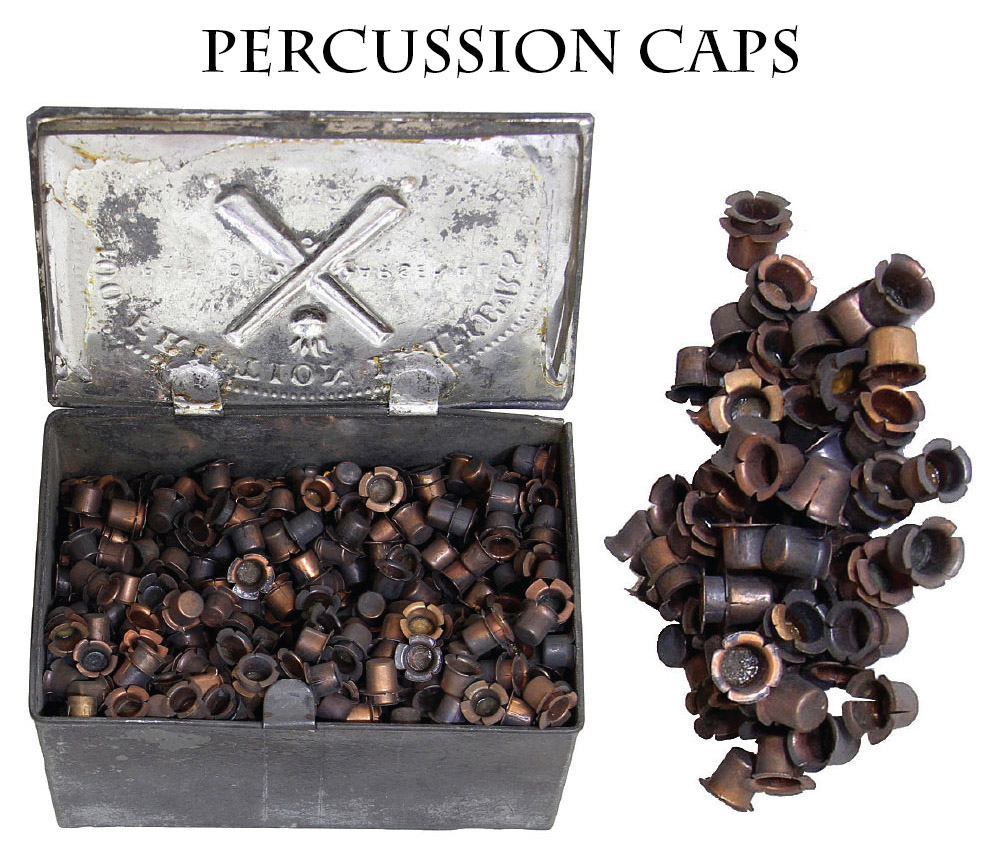
15-08-101 … Friction Primer Tin [Tin not for sale] and Percussion Caps … QUANTITIES GETTING LOW! …
I purchased this neat old relic and am offering the percussion caps inside the tin in this offering. This very scarce tin came just as you see it, filled with percussion caps for muskets. The tin itself is the arsenal tin used to hold artillery friction primers. These are darned hard to find! I can only think of one instance where I found one still in a primer pouch! The tin has a hinged cover with small latch and embossed top reading: 100 FRICTION PRIMERS in an arc over an ordnance insignia, and FRANKFORD ARSENAL on either side. I don t know who put the percussion caps in the tin, it was certainly a handy storage idea, but since they do not belong together, I am splitting up the lot.
In each package of ten cartridges the soldier got 12 caps. While the supply lasts I will sell the percussion caps …
One Dozen … … … $15
Two Dozen … … … $25
Five dozen … … … $50
Click Here to E-mail Us!
Call us @ 419-842-1863
Layaways are Welcome
Need to split your order into multiple payments? No problem! A simple 20% earnest money deposit will hold your item for you.-acf
You can then pay it off in easy installments that fit your budget.
Read Terms Here
Items to Sell? Contact Us
I am always interested in buying ANYTHING from the American Civil War… Guns, Swords, Civil War Muskets, Knives, Uniforms, Flags, Medals, Badges, Diaries, Letters, Autographs, Buttons, photographs, tintypes, daguerreotypes, Insignia, Camp Items, Battlefield Relics, canteens, Drums, Etc… Call 419-842-1863 and ask for Dave Taylor.

